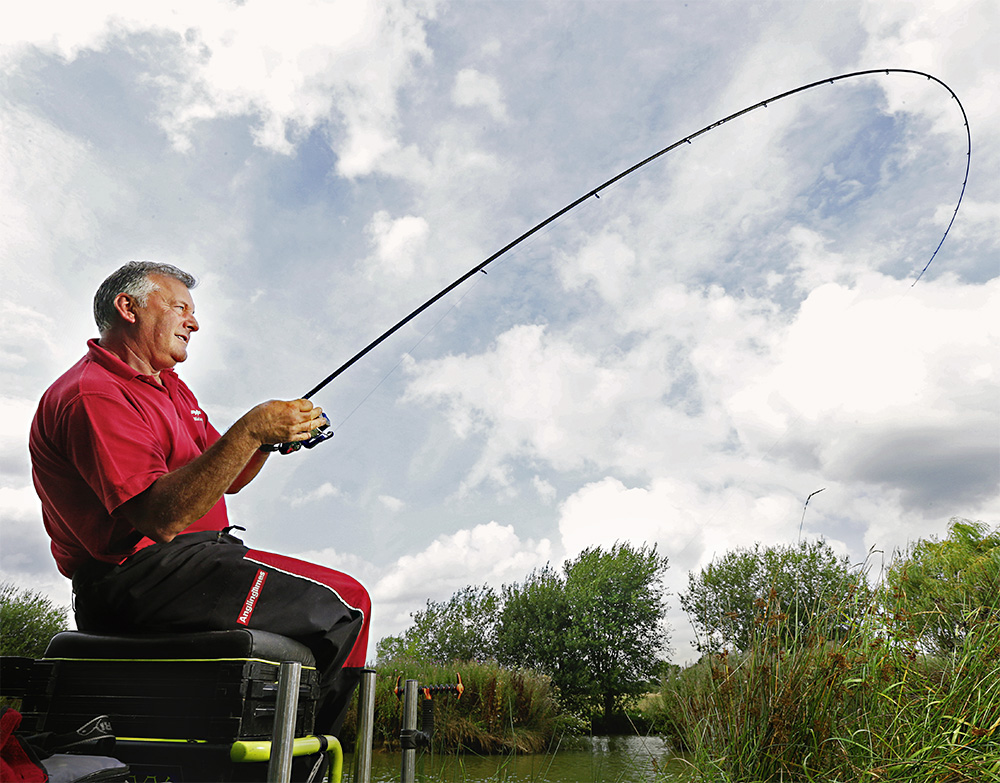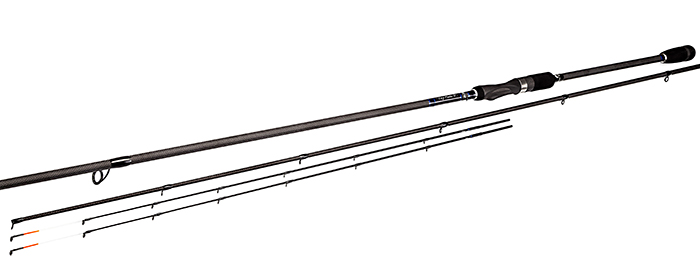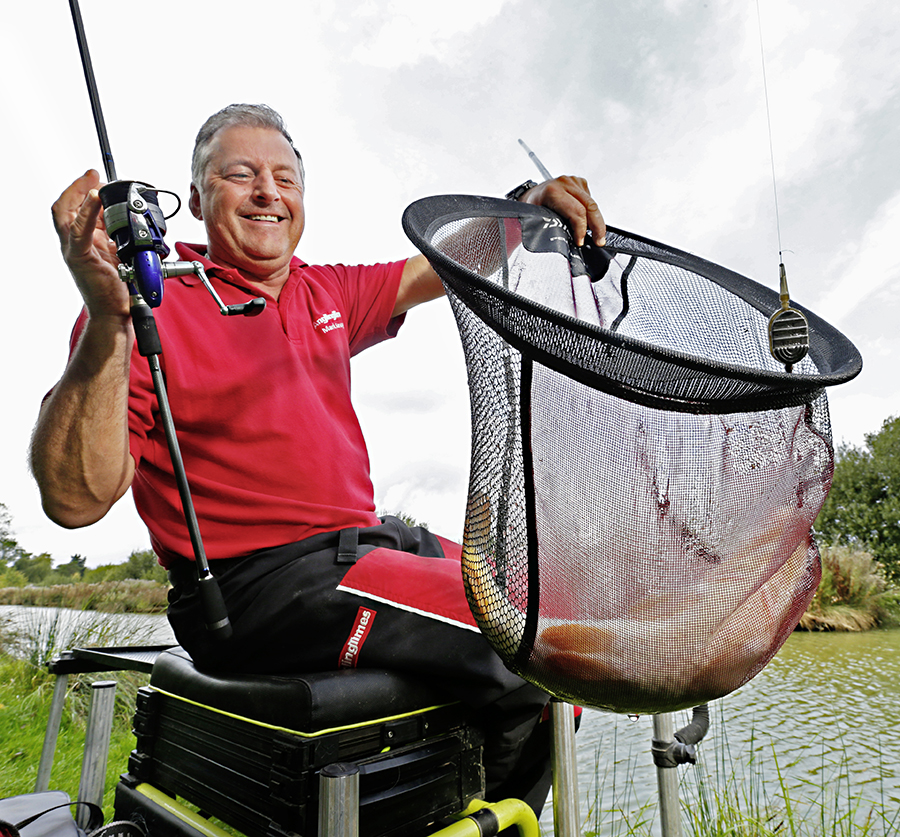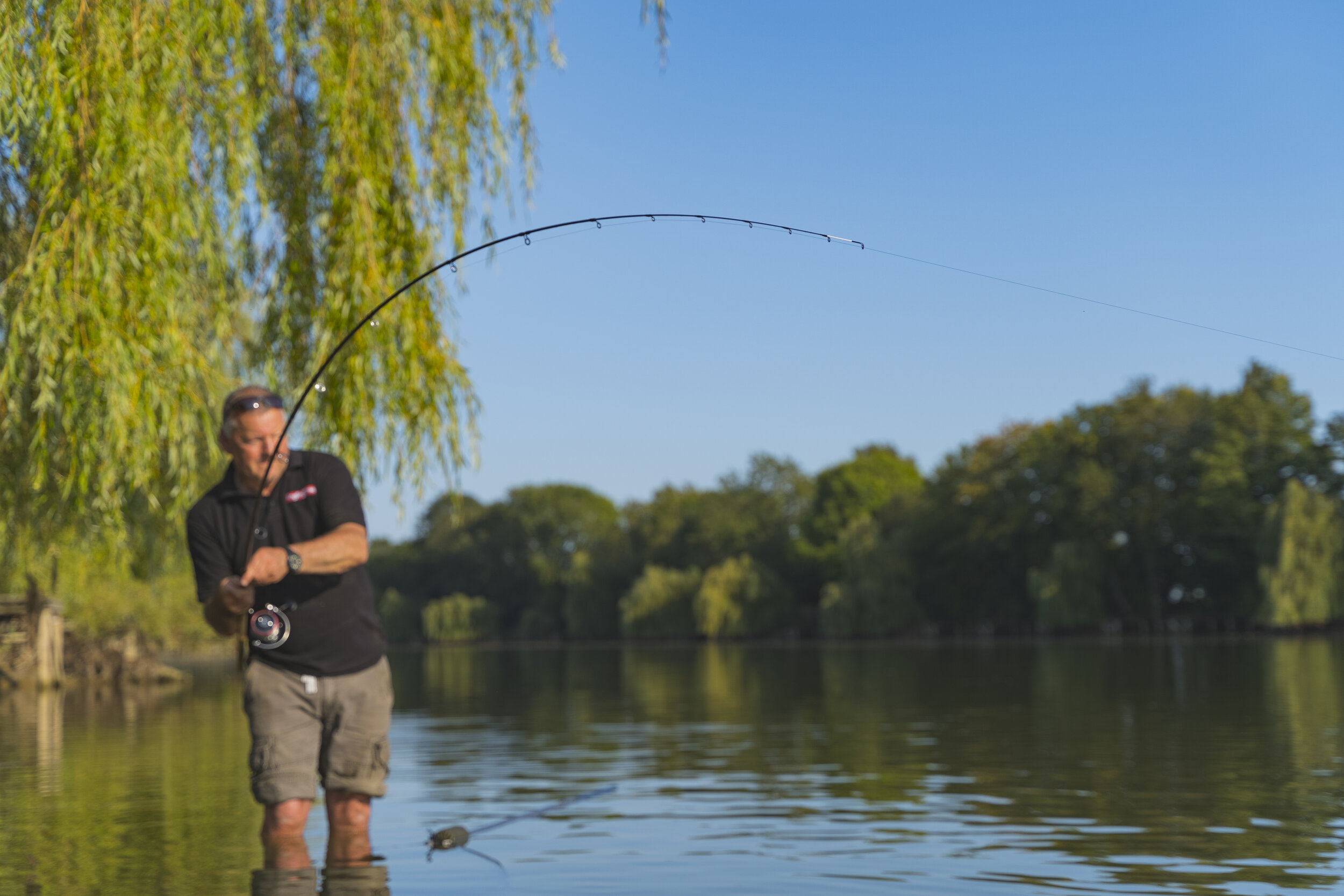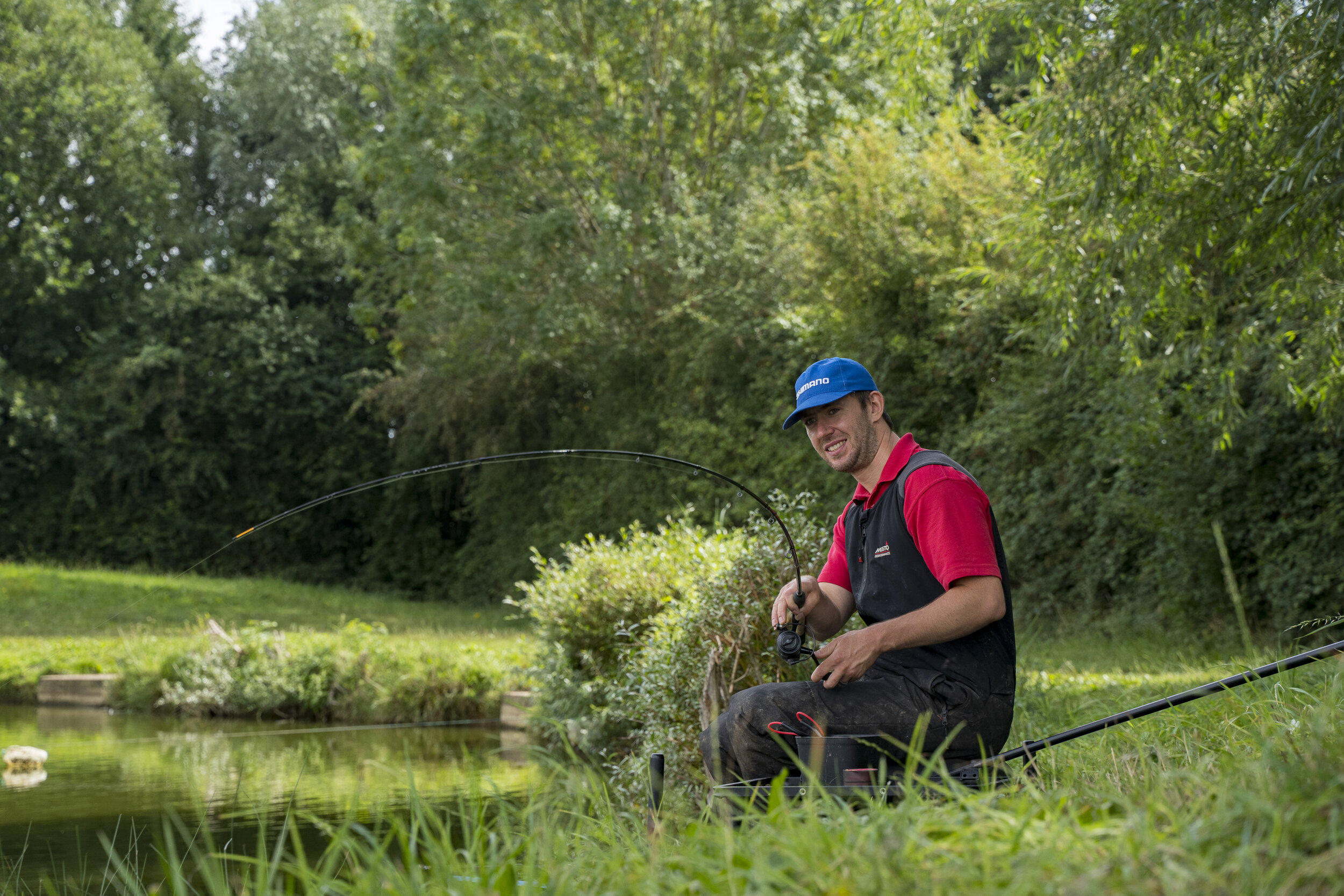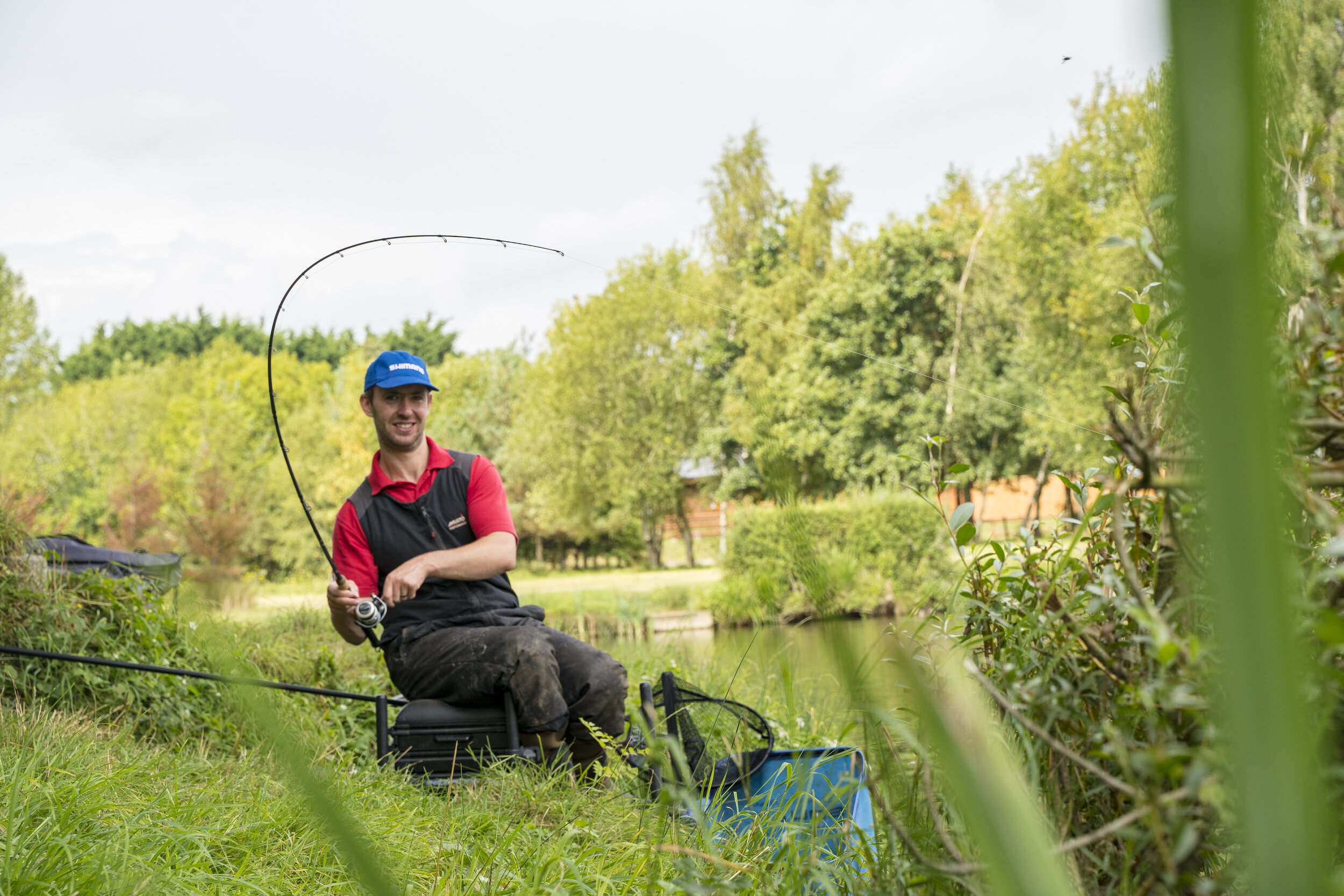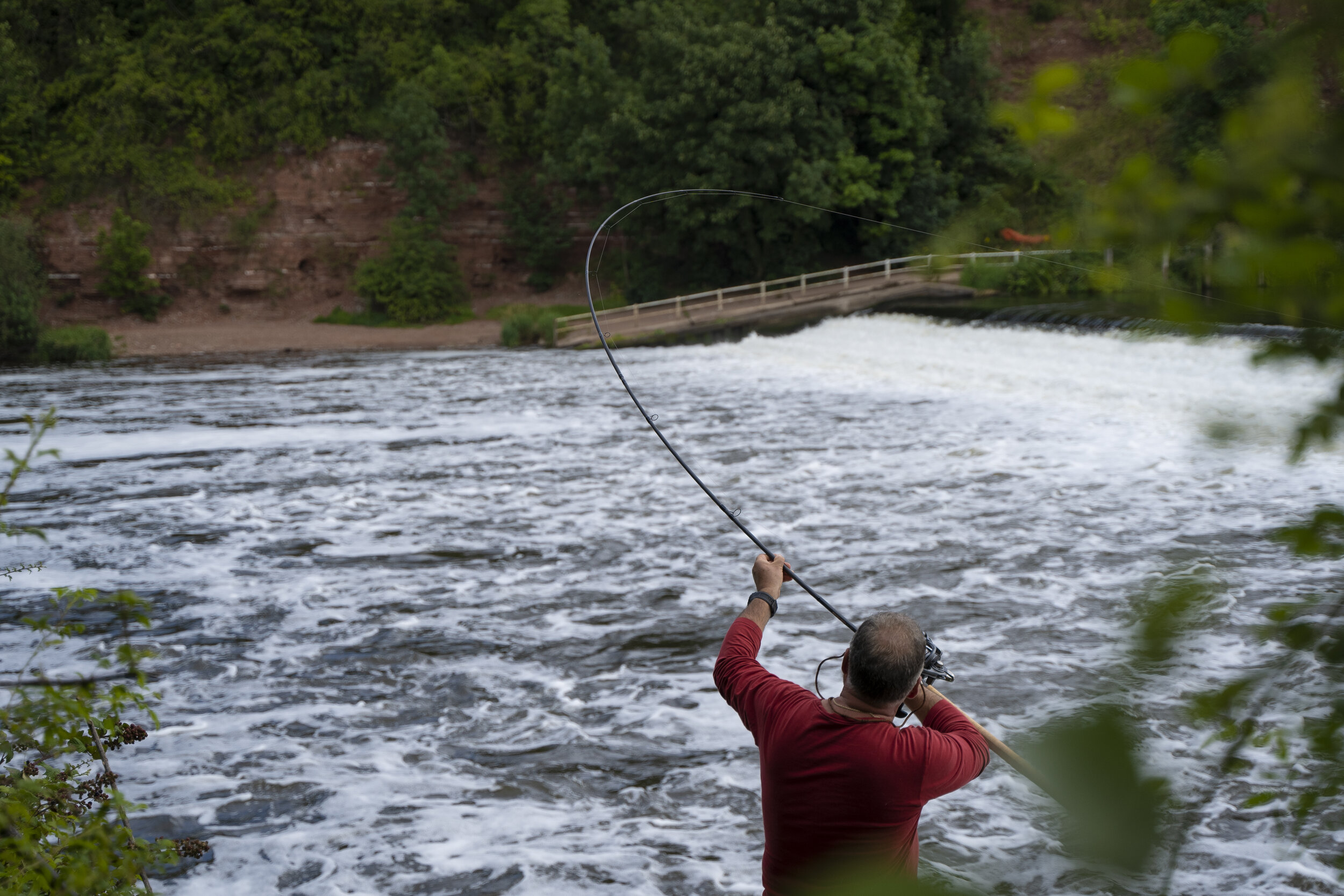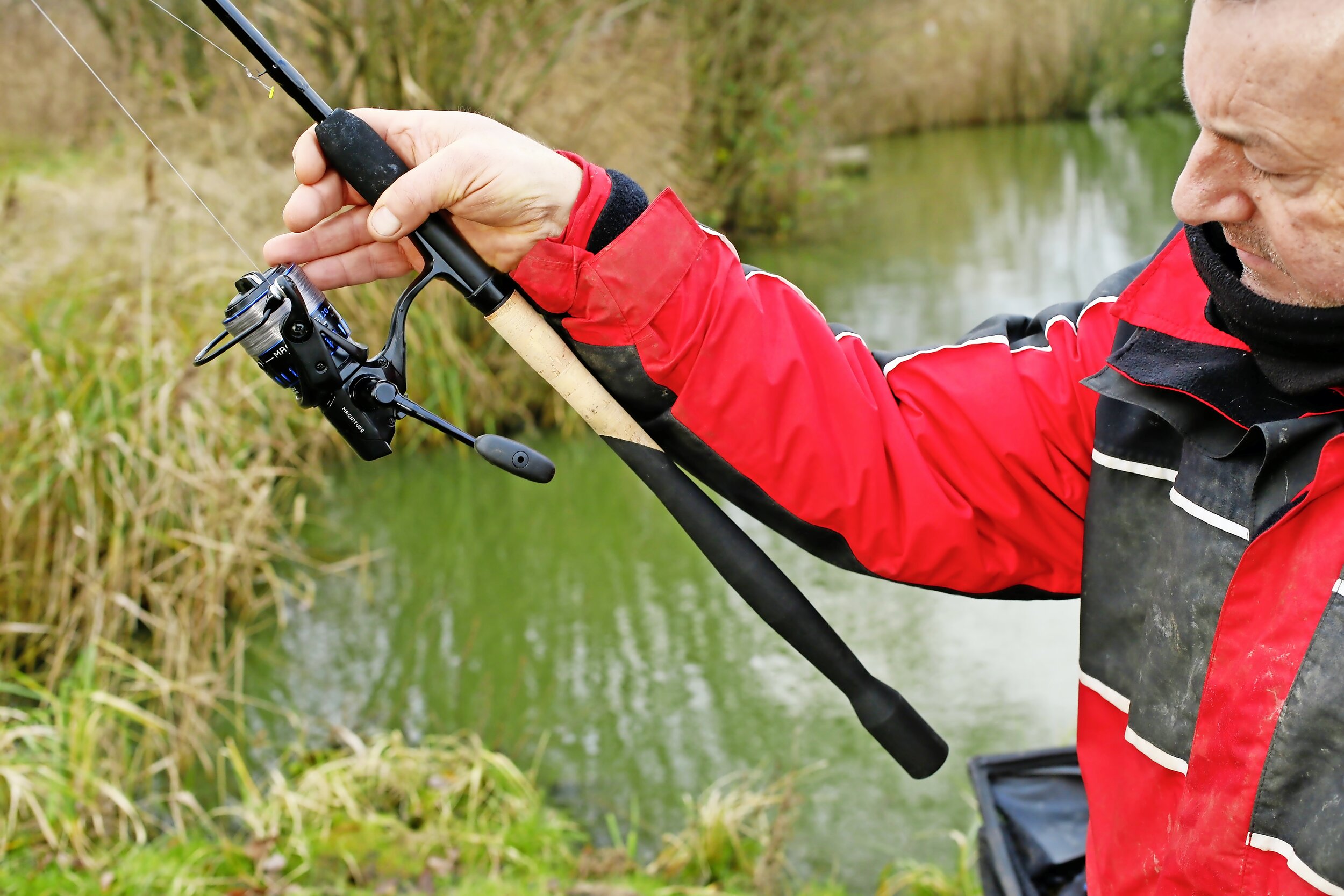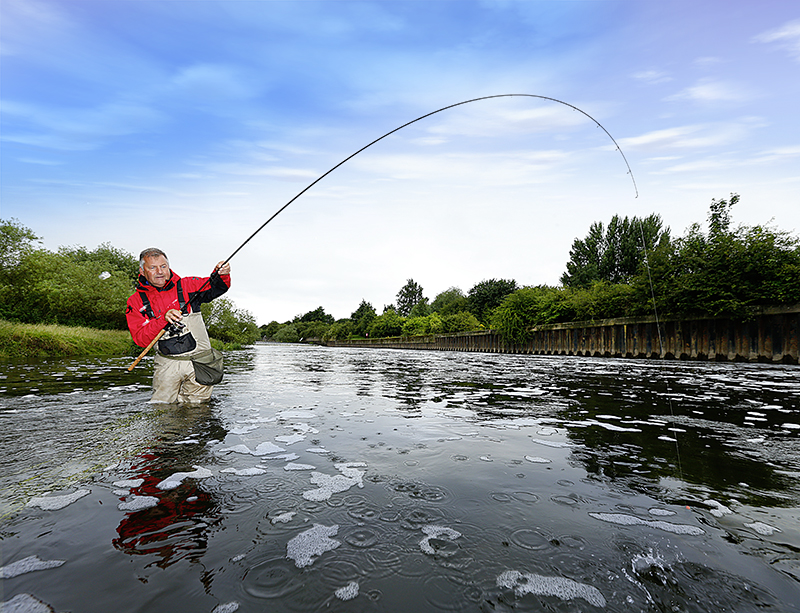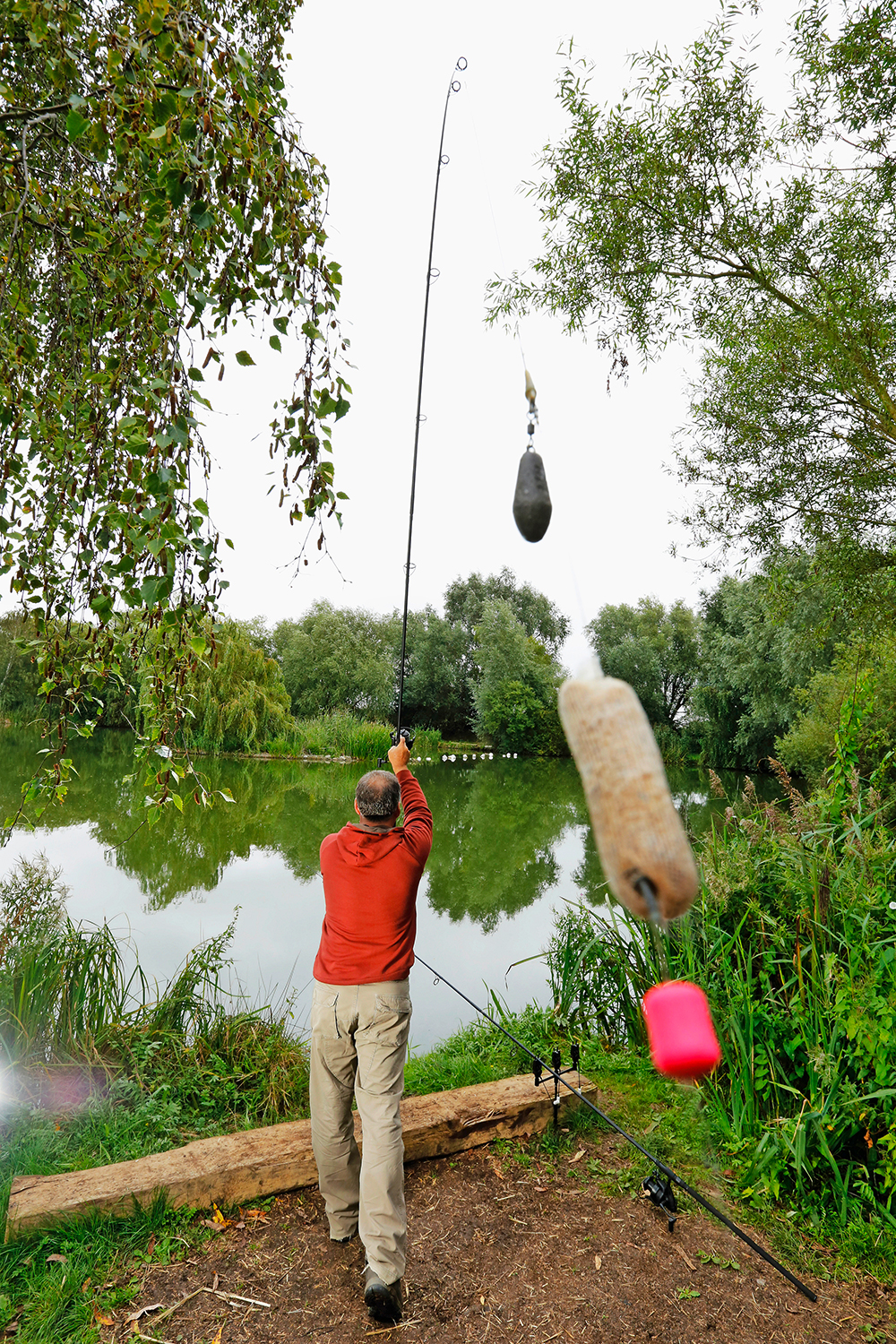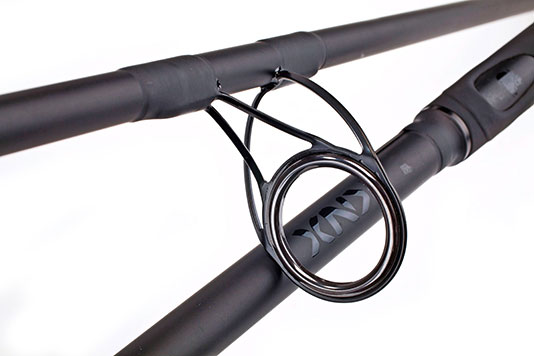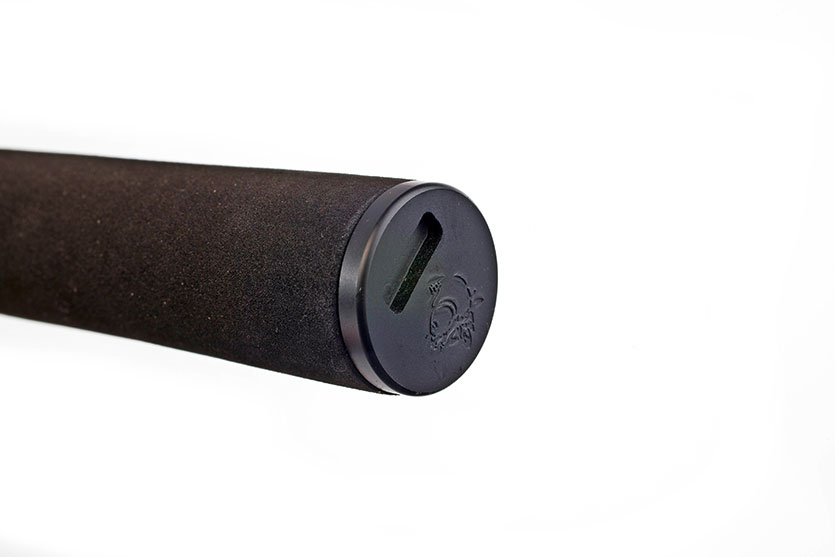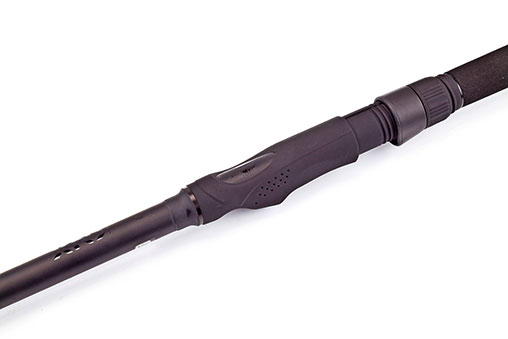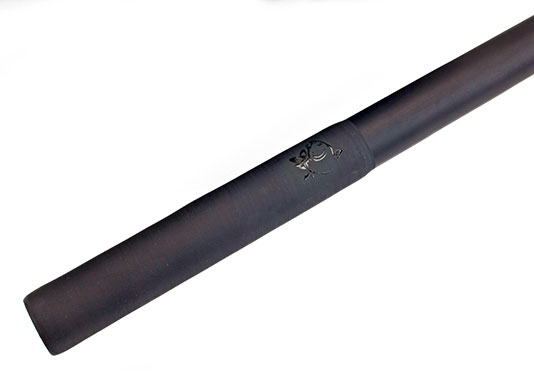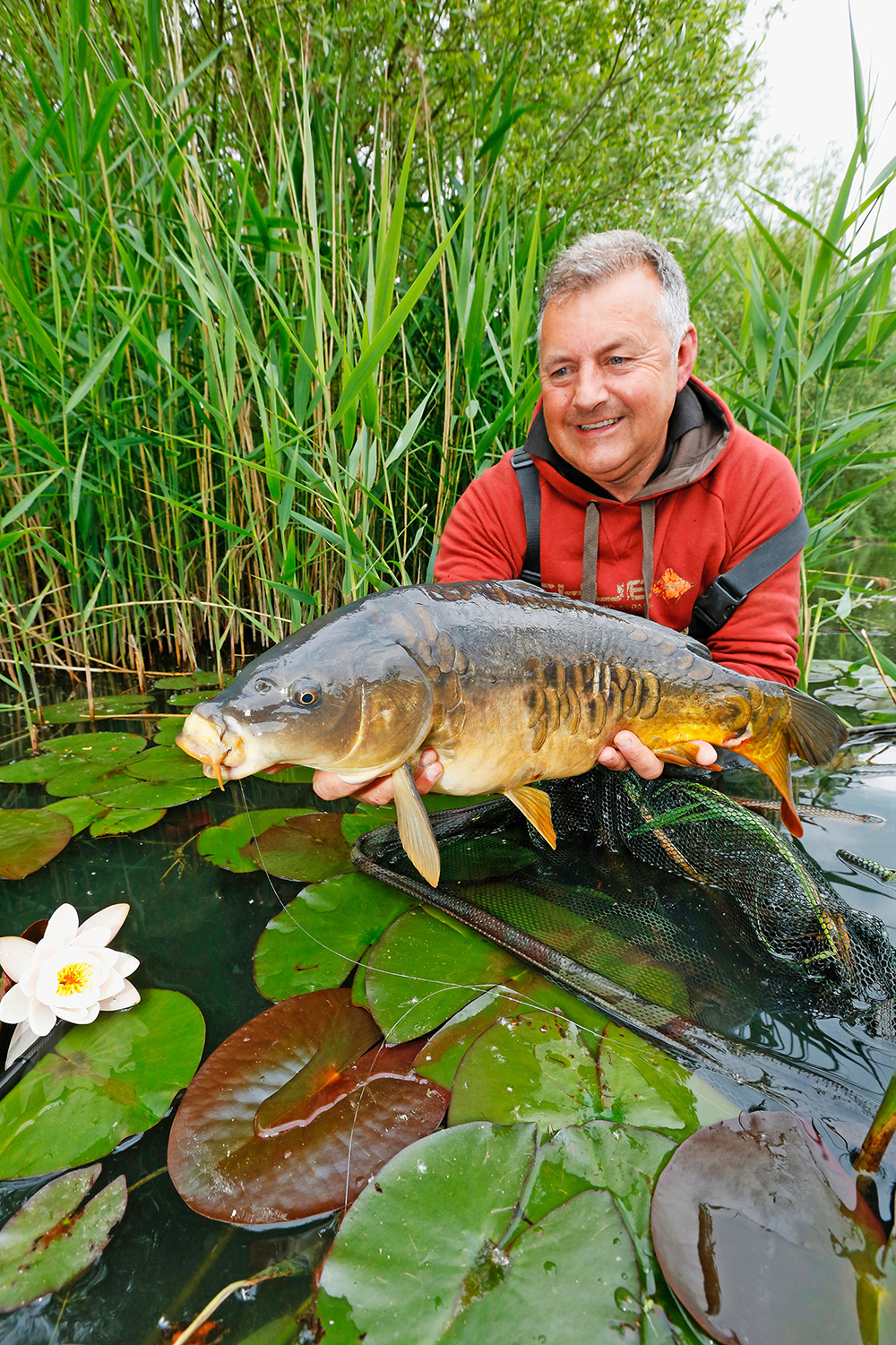Free Spirit Hi S Carp Feeder fishing rod
If fishing rods came with a pedigree, Free Spirit’s new Hi S Match rods would be pinnacles of the tackle trade aristocracy.
The company’s equally well-connected Hi S Carp rods have long been considered be the best that money can buy.
Free Spirit entered the match, pleasure, and specialist arena around three years ago with its mid-priced CTX range. But it was surely only a matter of time before match rods with the same top-spec build and quality carbon as the Hi S Carp rods entered the fray.
The comprehensive 16-rod Match range first saw the light at last year’s The Big One show, where those that saw them – me included – were wowed by their modern looks, quality fittings and almost frightening transmission of ‘feel’ through the blanks.
All are constructed from ultra-low-resin 40t carbon with woven butt sections. This makes them extremely light to hold, yet extremely strong.
The unique ‘Perdurable’ finish does away with paint or lacquer– it’s just the carbon, which is made to be ultra-resistant to damage and helps the rods to retain their showroom looks.
Hi S Carp Feeder rods (the 11ft version of which was on live test duty) are all fitted with high-end Kigan Z guides along the blanks themselves, while the quivertips bear anti-frap MZ rings that reduce the chances of the reel line or shockleader catching in them and causing a crack-off.
Something else that makes these rods that little bit different is their unique hollow quivertips. These eliminate any flat spots, since there is no abrupt transition from solid tip through to hollow blank – instead you get a seamless, progressive action.
To that lot you can add Fuji skeletal-style reel seats with a cut-away forward finger area, giving added feel and control when playing fish. Carp rod-style abbreviated handles allow easy directional changes when playing a hard-fighting fish close to the net, and ‘fold-friendly’ guide spacing allows you to break down a rod with reel and rig in situ.
Add all that up and you have to agree that Hi S Carp Feeder rods are a bit special.
Not only do they look classily different, they also feel and behave differently in the hand.
This was instantly apparent on the live test. The two-piece 11ft Carp Feeder rod is so slim in the butt section just above the handle – just 150mm in circumference – that it doesn’t look capable of casting a small float, never mind a feeder. How wrong can you be!
Not only will it chuck 3oz (85g) feeders with some ease, but it will propel them an awfully long way, certainly far enough to cope with most commercial venues.
The rod’s progressive action is equally admirable – the hollow quivertip gives it a seamless curvature, and it has enough power in its locker to cope with everything from F1s on light gear, through to big girls on heavy Method tactics.
The cut-away reel seat allows you to feel every movement of a hooked fish, and while the abbreviated handle may not be to everyone’s taste, it balances perfectly with the blank and is just the ticket for winding up a cast or piling on the pressure when it’s needed.
Mark Sawyer
PAY AROUND
£280 (abbreviated handle)
£300 (full cork handle)
Maver Reality 13ft Match Rod Review
Not so long ago a three-piece 13ft float rod would be standard issue for all match and pleasure anglers, and I’ll tell you why.
The industrial cities of Sheffield, Leeds, Rotherham and Birmingham gave rise to legions of angling aficionados (pardon the pun), many of whom worked in the nationalised coal and steel industries.
These had massive working men’s associations with affiliated angling clubs. Every weekend would see coach loads of fishermen arriving on the banks of the Witham, Welland, Trent, Severn and Thames, where float fishing with 13ft rods ruled the roost.
Those were the days, when fishing was basically the only recreation for many a working class bloke.
Tackle was functional first and foremost. Wicker creels, rods in canvas bags, Intrepid reels, Au Lion D’Or hooks, a handful of handmade floats – oh, and an Efgeeco baitbox containing a pint of ‘gentles’ in sawdust – was about par for the course.
The best float rods of the day were built mainly on fibreglass Golden Jubilee blanks, and appeared under the WB Clarke All-England, Milbro Enterprise and Billy Lane Match brands. The first carbon rods weren’t far away, though, although when Fothergill and Harvey launched them in 1975 they cost a king’s ransom at £133. Bearing in mind that back then a Mars bar cost sixpence (2.5p) and you get an idea just how expensive this rod was.
Thankfully, modern 13ft float rods are vastly cheaper in relative terms, as well as being better built, better balanced, lighter in the hand and an altogether superior product.
Enter Maver’s 13ft three-piece Reality, which can be found for as little as £49.99. It’s also available in 12ft and 14ft versions, and all three decent enough lightweight blanks with their medium-fast action will cast wagglers up to 25g.
Key features include a full cork handle with EVA lock-down foregrip, quality lined guides, folding keeper ring, and a classy jet-black glossy coating.
It’s not the crispest float rod I have ever come across, and it may lack a bit of finesse. But it can cope with whatever comes its way, as I discovered on the live test at Stretton Lakes’ day-ticket Silvers Pool, just off the A1 north of Peterborough.
I was hoping for roach with hopefully the odd better skimmer thrown in. Feeding groundbait laced with a few micro pellets and casters, my basic set-up saw a 3AAA straight peacock waggler attached to 3lb reel line, 0.12mm hooklength, and a size 18 hook with a double maggot as bait, fished overdepth.
Small roach and rudd gave me a bite a chuck, but these skerrets hardly tested the rod’s prowess. Bites then dried up, and I wondered if this was a prelude to the skimmers clocking in.
I didn’t have to wait long to find out. The float’s blaze top vanished and my strike was met with far more resistance than any skimmer could muster. The rod took on its full fighting curve in an action best described as on the stern side of progressive – pretty much what you need from a float rod if you’re likely to encounter bigger fish.
Eventually my balanced tackle got the better of a decent-sized carp, and what a handsome fish it was – bristling with indignation, it had clearly never been caught before.
The Reality Match had done its job, absorbing the carp’s every lunge without cause for concern. Yes, of course this rod was made to tackle silvers on rivers and stillwaters, but when it’s called to battle stations you’ll be glad to have it your side.
Our verdict: What's not to like about this rod? It’s very well priced, easy to use, feels reassuringly sturdy, and is ideal for all float work, trotting or static. As proved during the live test it also has a touch of steel about it, which means it will handle big fish with little hassle.
PAY AROUND
£46.99
Browning Black Viper Mk 2 13ft Review
The latest feeder rods bearing Browning’s Black Viper name are aimed more towards those who fish big open-water Continental venues than at your average UK commercial angler.
But did you really think I’d bother testing a rod of no use to anyone here in Blighty? Negative!
Within the range are three Black Vipers that I’m sure will appeal to the ever-increasing band of anglers who target bream, skimmers and even the odd carp on wide expanses of water such as Peterborough’s Ferry Meadows or Barston Lake in the West Midlands.
The trio in question are the 12ft 80g, 13ft 100g and 13ft 140g versions. In three sections, they are made from quality high modulus carbon fibre, and their good old-fashioned, slightly stepped-up action makes them deceptively powerful and accurate casting tools. This is especially true of the 13ft 140g rod being live tested (the 140g spec refers to the maximum weight it will comfortably cast).
All three rods perform equally well on still and slow-moving waters, and despite their fast action the carrier section is soft enough to enable the use of small hooks and lightish hooklengths without fear of fish losses.
This is a key factor when choosing a decent bream rod. You don’t need it to send cold shivers down your spine every time a proper bin-lid nods its head en route to the landing net, and in this respect the Black Viper is decidedly non-venomous!
In my book, Browning has been ahead of the game for the last couple of seasons in the design and construction of distance casting rods for bream. And regular readers of my tackle reviews will know of my fondness for the German firm’s outstanding (if rather expensive) top-of-the-range Sphere models. These are arguably the very best distance bream rods on the market.
Not that any of the Black Viper Mk 2 rods are the poor man’s Sphere – anything but, and with prices from £199.95 to £239.95 they will cause a sharp intake of breath as you hand over your hard-earned.
On, then, to the live test, and although the big-bream venue Ferry Meadows is basically at the back door of the Angling Times office it’s a tad out of form at present. Instead, a trip to Rysons Lake in Northamptonshire was hastily arranged.
This lake has two floating islands at around 65 yards and the fish drift between these. More often than not it’s a case of laying down a decent carpet of bait and waiting for the bream, which run to around 8lb, to turn up.
This tactic provided me with ample opportunity to test the rod’s casting accuracy and weight loading capacity. My large feeder packed full of groundbait, pellets, worms and dead reds weighs the best part of 4oz (113g), more than a decent test for a rod rated to a 140g maximum.
I got the feeling that the Black Viper was right on the line at 4oz, but that said, it went the distance. And once the feeding cycle was complete, it fairly sizzled out a loaded 35g feeder against the reel’s line clip.
Bites are detected via one of three supplied carbon push-in quivertips. The gaudily painted blaze and white tip ends may not be to everyone’s taste, but they show up well enough.
The real beauty of this Black Viper, though, lies in its ability to cast a long way and deliver a big soft-mouthed bream or skimmer safely back to you.
To that end it’s one sassy snake.
Our Verdict: Another absolute belter of a bream rod from Browning. Ideal for all stillwaters, I rather fancy that its casting prowess and cleverly cushioned softness will also endear it to those who line the banks of Norfolk’s River Yare every summer.
Sturdy low-profile Fuji K-guides, a full cork handle, and enlarged quivertip eyes (to allow for the smooth passage of shockleaders) combine to make the Black Viper Mk 2 another class act from the Browning stable.
Price: £239.95
Check out the video below for a closer look!
DAIWA 13ft Powermesh Specialist Float Rod Review
After around a 20-year absence, Daiwa’s iconic Powermesh rods are back with seven new Specialist models for the big-fish angler.
The full collection includes a bespoke two-piece barbel rod; 13ft, 14ft and 15ft float rods; and 11ft 6ins, 12ft 6ins and 13ft 6ins feeder rods with graded 1.5oz, 2oz and 3oz quivertips.
All are constructed from an identical high grade of reinforced carbon, the weave of which gives them that powerful, steely backbone we associate with the Powermesh name.
The rods are furnished to a very high standard, incorporating original Fuji reel seats, full-length cork handles and hard-wearing stainless steel frame guides with lightweight LS ceramic-lined rings.
To that little lot you can add a folding keeper ring, aluminium butt cap and a padded sleeve large enough to house a reel, so rods can be taken to the bank ready made-up.
With ‘demanding situations’ high on my live test objective sheet, a trip to a tackle-devouring stretch of the Trent was in order.
The river here is very shallow and clear, running fast over clean strips of gravel interspersed with waving fronds of streamer weed. You might just catch a glimpse of a pristine golden flank as a big barbel momentarily reveals itself.
As they say, ‘other methods are available’, but nothing beats presenting a bait beneath a float fixed top and bottom. From matching the weight of the float to the river’s flow, to slowing the travel of your bait at just the right moment, or mending the line before running your float through at the same pace as your loosefeed, trotting is an art form. Get it right and at some point your landing net will be graced with a truly stunning wild-born fish.
The rod on test, the 13ft Daiwa Powermesh Specialist Float, allows the use of heavy lines without feeling heavy or cumbersome in the hand, and will cast a waggler or stick float as the situation demands. There’s enough cushioning in the blank to permit the use of sensibly sized hooks and hooklengths.
A rod with all these qualities is a rare beast indeed, and on a day when the river had extra flow after recent rain it cast a hefty 6g alloy-stemmed balsa float without a hitch. At just 6.7oz, the rod caused me hardly any wrist fatigue while I waded the stream.
But it’s when a big fish is hooked that this Powermesh shows its true mettle. It boasts loads of mid-section persuasive power, but the sweet parabolic action cushions sudden lunges when needed, and it transmits plenty of feel through the blank.
In fact, it’s nothing like the broom handles that are often passed off as specialist rods.
Our verdict:
As well as being a river rod, Daiwa’s new 13ft Specialist Powermesh Float is ideal for big tench and bream on the float.
It will cast a big slider or bodied waggler a very long way when needed. It can also be used for big carp in the margins.
The rod is built to stand a bit of abuse, and with all that versatility it’s sure to find its way into the rod holdalls of a host of big-fish specialists.
PAY AROUND
£107.99
Sensas Black Arrow 800 11ft Medium Feeder rod review
French giant Sensas has added several superb feeder rods to its comprehensive range.
The Black Arrow comes in three categories – 300, 500 and 800 – and within each there are different length rods to cover everything from light leger work through to blasting a feeder 80-plus yards.
The 800 series are top-end rods, starting at £179.99 for the slender 11ft model and rising to £249.99 for the 14ft Super Heavy model. Four others are midway between.
I first got to have a play with the rods at the Sensas HQ just before Christmas, when UK boss Mark Downes was positively bursting with enthusiasm about his new arrivals. Forget what had gone before, he told me, these were the best rods Sensas had produced and, more importantly, they are designed specifically for the UK market. They looked good and felt lovely in the hand, but as ever, there’s only one way to give them a proper going over – hook something that pulls back!
With the pick of the 800 series to go at I went for the 11ft model. This is your typical tip rod that’ll do everything from river bream fishing to a spot of mixed fishing on lakes, and arrives with three tips of various grades.
I headed to Kingfisher Lake on the Townsend complex in the heart of the Fens, home to lots of big skimmers plus F1s, crucians, tench and, of course, plenty of carp. There’s a sunken island to cast to at around 40 yards, a good enough chuck to test the rod’s action and accuracy when teamed with a little flatbed Method feeder.
First cast was on the money, and made so easy by the cracking through action of the Nanoflex blank. It’s smooth, and lacks the overly-aggressive power of some rods that can see a cast fall short due to the lack of forgiveness down the rod. Bite number one to three dead red maggots was not long in coming, and a 1lb skimmer was duly wound in – they don’t fight much on a size 16 hook and 4lb hooklink.
To get a good idea of how the rod acts when a fish is on I really leant into the next one, a bigger skimmer of around 2lb.
The rod is superby soft down to the mid-section, and you can really put a bend in it without any danger of a hook-pull. Already I was thinking that this was the sort of bream rod I could have done with 20 years ago when fishing the Fen drains and River Welland.
Skimmers are all well and good but they don’t exactly fight. A change was needed to get a bigger fish, so on went a banded 6mm pellet and after a few minutes, a 3lb F1 obliged.
This was more like it! On the strike the rod locked up quickly to set the hook but then relaxed as the battle began. Once again, leaning into the fish sent the Black Arrow into a perfectly-crafted bend but still had plenty more to give when the fish took off.
Once under the rod-tip, which is where a lot of fish are lost as they bounce around, the rod cushioned every lunge handsomely, and the F1 was netted. A dozen more followed, plus a few more skimmers, and none posed a problem. Nor did I suffer a hook pull or a crack-off on the strike. That was remarkable, as I can be cack-handed at times.
The true test would be when a proper carp turned up and, sure enough, one did. I can’t fib and say the fight wasn’t without a few nervy moments but nothing to send the old ticker into overdrive.
I would say that the Black Arrow is not a rod for dealing with carp alone, as it is too soft, but then that’s not what it was built to do. After all, you wouldn’t fish the pole with a match kit for big fish, would you?
Our Verdict: From the moment I hooked that first fish I liked the rod. It’s soft, forgiving, casts like a dream and you can get anything out that you hook. I wouldn’t fish for carp with it, though, but on a mixed fishery or a trip out for bream and roach on a slow-flowing river it’s a belter. With other options in the range, Sensas Black Arrow rods are all you’ll need if you take your feeder fishing seriously.
Price: £179.99
Preston Innovations 11ft Monster Pellet Waggler Review
BUY NOW for £94.99 at Chapmans Angling
Preston Innovations has recently introduced four rods aimed at anglers who fish commercials. The Monster range includes two Carp Feeders, a Method Feeder and a Pellet Waggler model.
All are packed with key features such as unique low-profile reel seats that bring the reel closer to the hand, making the rods easier to fish with. To these you can add EVA butt and thumb grips for added casting support, and low-profile lined guides that greatly reduce tangles and the likelihood of snap-offs on the cast.
Two equal-length high modulus carbon sections make the rods a doddle to carry to your peg ready made-up. All this adds up to innovative, well-built rods with plenty of key features, utilising the latest technology. Despite this they are priced sensibly enough not to cause the missus to throw a hissy fit when the Barclaycard bill hits the hall carpet.
Not that these rods are merely cosmetically pleasing – Preston has refined their performance, which results in a slightly beefier backbone than before. You get more casting clout and extra pulling power through mid-sections to show the biggest of fish who’s boss.
So, with the summer sun in full water- warming mode, and carp cruising about all over the surface everywhere I’ve visited, it was high time I took a much closer look at the new Monster Pellet Waggler.
This 11ft rod, the name of which says it all, has had plenty of input from world-renowned anglers Tommy Pickering and Des Shipp. Together they probably know more about how a fishing rod needs to perform than the rest of us put together.
My live test venue was Steve Gregory’s Horseshoe Lake, on the day-ticket Rushfield complex near Lincoln. Its heavyweight carp are suckers for their pellets, and always willing to feed close to the surface – ideal candidates for pellet waggler tactics.
My set-up was simple enough – nothing more complex than a 6lb reel line matched to a 6g pellet waggler float, 0.17mm hooklength and size 16 hook with a 6mm banded pellet.
The rod will cast floats up to around 15g, but there’s not quite enough whip in the tip for it to cope with anything much less than about 4g.
Firing in little more than half a dozen 6mm pellets every 20 seconds or so, it wasn’t long before dark shapes hove into view as soon as the feed hit the water. However, as often happens on a well-fished venue, as soon as the float splashed down, the fish disappeared.
The trick is to feed twice, immediately before and after casting. But you will also need to feather the line, so that the float lands with a gentle kiss rather than a sloppy smacker on the water’s surface. Get it right and bites will be savage. But you need to get your hooked carp out of the feeding zone as quickly and quietly as possible.
To do this you need the reel’s clutch set quite tight, but not locked up. Then, with the rod tip kept as low as possible to the water, lean into the fish. Without changing the rod’s position, pull and wind at the same time until your quarry is within netting range.
Once you’ve done this a couple of times, playing even the largest carp becomes pretty straightforward, provided you have full confidence in your kit. And this is where a rod with the performance of the Monster Pellet Waggler really earns its corn. Its progressive action will cope with all the lunges and head-shakes of a big carp with enough muscle through the middle to lower section areas to keep you in charge at all times.
Even when the blank is under full parabolic compression its non-locking action provides enough of a safety buffer for you to dish it out without hook-pulls or snapped lines.
The blank was able to deal equally well with other species. Plenty of smaller F1s and ide joined the party, and although they don’t have the fighting qualities of big carp they are still welcome weight-builders in a match. With some other pellet waggler models these smaller fish tend to come off at the net when the rod is held in a vertical position. But I can happily report that such irksome events don’t occur with the Preston rod.
Mark's verdict:
Preston Innovations’ new 11ft Monster Pellet Waggler rod is the ‘one size fits all’ answer to all commercial pellet waggler scenarios.
This to be fair, covers everything except perhaps long-distance work with heavy floats on open water venues such as Boddington Reservoir.
The progressive action is about as good as it gets in its price bracket, and it seems to have the happy knack of kicking in at just the right moment, giving the extra oomph needed to play big fish. Despite this steely side, the blank is light enough to be held for long spells without discomfort, an immense help when you are catapulting out feed little and often.
BUY NOW for £94.99 from Chapmans Angling
Matrix Horizon XD Class 130g 13ft review
Tech Spec
- Specifically designed for distance feeder fishing
- Casting weights up to 160g (4.5oz)
- Ultra high modulus carbon blank
- Extended spigot joint for improved casting power
- Oversized guides enhance casting performance
- Slim fast taper, fast-actioned blank
- Supplied with carbon tips of 2.5oz and 4oz
- Unique detailed weave print applied to all sections
- High-grade cork and EVA composite handle
BUY NOW from £169.99 at Chapmans Angling
It's always struck me as slightly ironic that many of the best distance feeder rods are designed by our Continental counterparts.
That said, modern UK match tactics are starting to influence the build characteristics and specifications of many rods, wherever they are made, and the four Horizon XD Class rods from Matrix are a case in point.
The emphasis across the Channel used to be on propelling a feeder a long way, but now more thought has been given to the cushioning effect that allows the user to reel a big ‘bin lid’ back without pulling a reasonably sized hook out of its mouth. This is reminiscent of our home-grown bream tactics.
These latest three-piece Matrix Horizon XD Feeder rods, in lengths of 13ft, 14ft and 14ft 7ins, and with maximum casting weights of 100g, 130g, 150g and 160g, all feature extended spigots for added casting power, and enlarged guides (including on the quivertips) that shockleaders and heavy lines can pass through unhindered.
The blanks are of the fast taper type, with high weight loading areas and a rapid post-cast tip recovery rate. All are bound to put a few extra yards on your cast.
Four models will be of particular interest to the UK bream angler who frequents large open-water venues such as Bough Beech Reservoir in Kent, or Coventry’s Meadowlands Fishery. They are the 13ft 100g (3.5oz) and 13ft 130g (4.5oz), 14ft 150g (5.2oz) and horizon-busting 14.7ft 160g (5.6oz) rods. For the live test I chose the 13ft 130g rod, which I reckon will be the best seller in the range.
It looks and feels ideal for out-and-out bream and skimmer venues such as Ferry Meadows, near Peterborough.
Rather handily, this was where I came across a certain Mr Steve Ringer who was practising for a forthcoming match.
After a little gentle persuasion, World Feeder Champ Steve agreed to let me use his seatbox, feeders and bait to run the rod through its paces – despite knowing it would likely mean the spoilation of his carefully fed swim.
Instead, selfless Steve decided to have a wander round the venue for an hour rather than watch me cast all over the place and ruin his chances of catching anything else!
So, what are you likely to get in terms of performance and handling from the new Matrix Horizon XD Class? I can tell you straight off the bat that it can be used with any type of feeder, although I found the window type best to achieve distance and accuracy. This is probably more down to the feeder’s sleek design and rear-end casting weight than to how well the rod propelled it.
In truth, the new 13ft 130g Horizon XD will cast anything you care to tie on to your line up to 3oz in weight, and do it with sublime ease. At 4oz, though, the blank’s mid-section lacks just a tad of steel. It still managed to chuck 80 yards-plus without too much effort, and I suspect better casters than I’ll ever be would take it to the next level.
But face it, how many stillwater match anglers are regularly casting 4oz weights those sorts of distances anyway?
Were I looking to use beefier feeders at super-long range, my choice would be the 14ft 150g (5.2oz) rod, which packs a fair bit more oomph.
Back to the rod under test, I can happily report that the 13-footer has a nicely cushioned parabolic through action, with just the right blend of power and subtlety from mid to tip sections.
This means it can be used with lightish hooklengths from 0.12mm upwards and size 16 hooks or bigger, with either mono or braided mainlines from 4lb-10lb. Thanks to its enlarged guides it can accommodate a shockleader too.
The verdict: The four new Matrix Horizon XD Feeder rods are quite specialised, and almost certainly made with an eye to the massive European demand for rods of this type.
They are still likely to find their way into the holdalls of UK match anglers who regularly fish open-water bream venues.
They are easy to cast a fair distance, even in the hands of inexperienced anglers and without heavy weights. A non-aggressive action gives a cushioning effect, so the rods can be used for skimmers and big bream alike without resorting to big hooks.


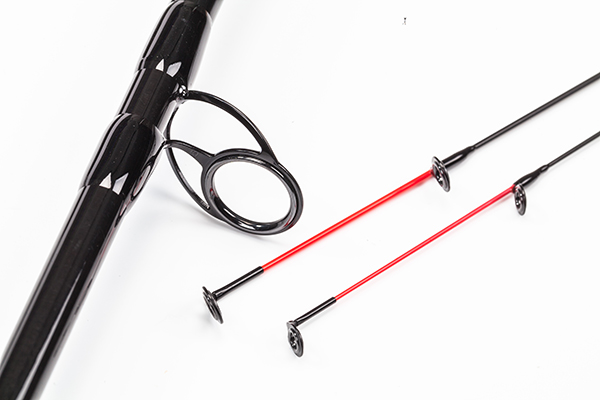

Tri-Cast Trilogy F1 10ft Waggler Rod Review
The latest British-built rod in Tri-Cast’s prestige Trilogy series is light in the hand but heavy on performance.
Weighing just 132g, the Trilogy F1 Commercial Waggler 10ft (a bit of a mouthful, that) has to be one of the most technically advanced short float rods ever made. It’s built from the same carbon cloth currently used in the aerospace and F1 motor racing industries.
A phenomenal line pick-up speed, matched with a thoroughly forgiving, progressive action, allows the angler to strike at lightning-fast bites without fear of snapping off a light hooklength. The cushioning effects of the rod’s top section sees to that.
The pencil-slim, two-piece blank’s equal-length sections are furnished with 10 featherweight single-leg SiC ceramic lined guides. These, whipped on with electric blue and silver-tipped thread, are spaced at carefully calculated decreasing distances towards the tip of the rod to give it a seamless fish-playing curvature under stress.
I was rather hoping to see this in action while live testing the rod on the banks of Norwich’s finest commercial, the F1 and carp-stuffed Willow Lake at Barford Fisheries.
It’s obvious from the moment you slide together the two sections of the new Trilogy F1 that this is a very special, if somewhat specialised, fishing rod. Clearly aimed at the commercial match angler looking to bag up on F1s and stockie carp, the blank feels crisp and almost rigid in the hand. But, as Tri-Cast claims, it does indeed give sufficient cushioning through the top section to alleviate breakages.
This I discovered when attempting to connect with the super-fast bites F1s give, especially up in the water.
I had tackled up with a 4lb reel line and a 0.13mm hooklength terminating in a size 18 hook, baited with a banded 6mm pellet pretty much standard F1 kit.
I started the session on a slim 6g balsa pellet waggler, which the blank handled easily enough, although I ended up using a stubby 4g model once I felt the fish were becoming wary of the longer float.
Maximum casting range with the Trilogy F1 if you want to keep things super-accurate is around 40m. Floats with a casting weight of 8g-10g would be as heavy as I’d fancy loading up with.
As it turned out, the fishery was deluged by a storm of Biblical proportions, with thunder, lightning and torrential rain – and the lake’s sturdy F1s became even more fidgety and difficult to catch.
However, swings and roundabouts – the larger carp, always up for a shallow-fished pellet, went on the rampage and tested the rod to its limits. You can’t help but be impressed with a 10-footer that casts arrow-straight, is easy to hold in one hand while feeding, and can deal with F1s and carp to double figures on reasonably light gear.
On the day I was accompanied by Angling Times features editor Richard Grange, a colossus of a man not noted for his deftness of touch. As he said: “Right, mate, give us a go with that rod,” I had visions of splintered carbon shards in his shovel-like hands and a ‘sorry but’ email to Tri-Cast’s Steve Hopkinson.
But as I sheltered from the monsoon under the rear door of my car I watched in awe as Sid
(for so he is known by his colleagues) slid the net under half-a-dozen great big carp in double-quick time.
The little rod bent almost double, and in keeping with his almost Vicious (see what I did there?) style there was no messing about from the old boy.
As the sixth fish was deposited in the keepnet, a sodden Sid turned to me and said: “Well, that’s a bit special isn’t it?” That seemed to sum up the rod’s performance brilliantly.
Angling Times says:
This super little rod is aimed squarely at the commercial match angler. It’s very well thought out, brilliantly built, and furnished with top-end fittings all round.
But where the Trilogy F1 really scores for me is in its flexibility – you can fish pellets in summer and switch to autumn/winter wag and mag tactics with equal success.
Ideal for use with reel lines from 3lb-6lb and hooklengths down to 0.11mm, this little beauty is bound to be gracing the holdalls of many anglers who appreciate pure class.
Price: £169.99



Shakespeare Cypry carp rods
To the best of my knowledge these new Shakespeare Cypry rods are the first from Shakespeare to be aimed specifically at carp anglers. Priced to appeal to the novice, junior or ‘just about managing’ carp fan, the line-up of 10 rods includes three-piece and telescopic models – popular on the Continent, less so over here.
BUY NOW from £32.99 at Amazon.co.uk
It’s the three 12ft two-piece rods with test curves of 2.5lb, 2.75lb and 3lb, as well as the beefier 13ft 3.5lb and 10ft 3lb rods (for work at close quarters) that will be of most interest to UK carpers.
The full carbon, two-piece blanks all feature an abbreviated handle with EVA thumb and casting grips, reliable screw-down reel seat, and a set of six hard-wearing ceramic-lined guides.
As I have said many times before, I hate using a carp rod that feels like a reincarnated telegraph pole. One of the best aspects of carp fishing is feeling the fight of the fish. If you stifle that fun by using a poker-stiff rod, you take away much of the motivation for going carping in the first place!
Now, I know there’s a time and a place for beefy carp rods. If you need to chuck a heavy lead a very long way you need something with the power to do the job.
But frankly, most carp anglers don’t demand such extreme performance. Many of them fish relatively small lakes where a 100-yard cast would land the rig in the trees on the far bank, in someone else’s swim, or even in a completely different pool.
Consider this too – an increasing number of pleasure anglers use a carp rod as a second ‘sleeper’ set-up, sitting it on a bite alarm beside them while they fish a pole or feeder. The aim is to produce one or two bonus big fish during the day, and the chances of that happening are greatly improved if the rod in question can chuck a baited hook a manageable distance where loosefeed can be accurately placed in the same area.
So, when putting Shakespeare’s budget-priced Cypry 12ft 3lb test curve carp rod through its paces, I knew I’d taken hold of a bit of kit that should prove hugely popular with a large number of anglers.
For the great majority of venues, this rod will cover every eventuality. Its workmanlike action will handle reel lines from 10lb to 15lb, and cast large Method feeders and solid PVA bags. In the hand it’s reasonably light and comfy, and it gets a big tick for its surprisingly responsive tip, which generates considerable casting clout when needed.
Plenty of transmission makes it a joy to play fish on – you can really feel every twist and turn of a hooked carp. The progressive action firms up quickly around the mid-section, providing enough backbone to steer fish away from snags and safely into your net.
During the live test at the quite superb day-ticket Willowbrook carp lake in Northamptonshire I used a variety of tactics to land fish approaching 20lb – small PVA bags, Method feeders and even surface controllers were well within the rod’s capabilities.
I got to thinking that it wasn’t all that long ago when I’d have expected a rod with this one’s build quality and all-round performance to set me back at least £100. At less than a third of that, the Cypry is an out-and-out steal.
THE VERDICT
Shakespeare’s Cypry range is ideal for anyone wanting to get into this addictive branch of fishing. It offers the would-be Terry Hearns lots of tactical scope, with enough power to handle Method feeders and solid bags.
A progressive action enables L-plate carpers to hit distant marks if and when required, but at the same time they needn’t worry that fish will break the line or pull the hook out at the net.
Mark Sawyer
Sensas Black Arrow feeder rods
The Full Range
Black Arrow 800 Feeder
11ft medium – £179.99
12ft medium – £189.99
13ft medium – £199.99
13ft medium/heavy – £209.99
14ft heavy – £229.99
14ft super heavy – £249.99
Black Arrow 500 Feeder
9ft medium – £129.99
10ft medium – £139.99
11ft medium – £149.99
12ft medium – £159.99
13ft medium – £169.99
Black Arrow 300 Feeder
9ft medium – £59.99
10ft medium – £69.99
11ft medium – £79.99
12ft medium – £89.99
Feeder fishing has seen a massive upsurge in popularity, and nowadays the well-prepared match angler has a rod in his holdall that suits every eventuality.
Much of the fervour associated with all things feeder fishing is down to our friends from the Netherlands, who have made the tactic an art form.
Little wonder, then, that one of the largest Continental tackle and bait companies, Sensas, has brought out what looks to be the most comprehensive range of feeder rods yet under the name Black Arrow.
There are 15 rods in all, in three price bands – the 800, 500 and 300 series. The rods are built from Nano-Flex carbon and all blanks are furnished with quality ceramic-lined guides and supplied with three push-in quivertips, graded to suit the various test curves.
Sensas has achieved the perfect combination of power for casting with softness at the fish-playing stage, and running the gamut of slender 9ft light feeder models through to hefty 14ft super rods for long-range chucks on big lakes and rivers, there’s something for everyone.
11ft Preston Innovations Monster Carp Feeder
TECH SPEC
- Casting weight: 15g-80g
- Line rating: 4lb - 8lb
- Length: 11ft (two equal sections)
- Guides: Low profile, ceramic-lined
- Handle: Cork hand & EVA
- Action: Powerful but progressive
Preston Innovations says its new Monster Commercial Carp rods are purpose-built to cope with the ever-increasing size of carp on many modern match waters.
BUY NOW for £94.99 at Amazon.co.uk
Big guns Des Shipp and Tommy Pickering have had an input into the design of all four, which don’t sacrifice any of their progressive fish-playing action despite being strong as Shire horses on steroids.
All rods are sensibly priced at under £100. There are 10ft and 11ft (on test) Carp Feeder models that come with graded push-in carbon quivertips of 1oz, 1.5oz and 2oz.
There’s also a dedicated 12ft Method Feeder rod, as well as what looks and feels to be a very handsome 11ft Pellet Waggler.
All four boast super-slim butt sections, cork and EVA thumb grip handles, secure screw-down reel fittings and quality low-profile ceramic-lined guides.
A useful keeper ring adds a nice finishing touch. Equal length two-piece blanks in all cases are easy to transport to your peg ready made-up.
The 11ft Carp Feeder, my Monster rod of choice for live test duty, is a tactically flexible feeder and straight lead tool. With an 80g (2.8oz) maximum casting weight, and rated to lines between 4lb and 8lb, it’s perfect for commercial fisheries where the carp have not signed up for Weight Watchers.
To prove its mettle, I needed to get the rod on to a water where bites come readily to a variety
of tactics, and few fit the bill better than the picture postcard day-ticket Lakeside Fishery near Towcester, Northants.
A swim opposite a small island gave me the option of a cast toward either corner or a long chuck out into open water to test the rod’s casting potential.
Setting up with Preston’s latest Inter-change feeder system allowed me to swap between different weights of Method and Banjo feeders, and with a straight lead line in the margins I pretty much had most of the tactics you would use with this rod covered.
Starting live test proceedings with a modest 15g flatbed Method cast tight to the island margin, I can report that at distances of up to 25 yards it casts sniper-straight, and that once you have clipped up, consistently hitting the target at anything up to 50 yards shouldn’t prove a problem.
This proved to be the case with feeders up to about 48g, after which the rod began to show its limitations. However, towards the end of the session I was still chucking a 30g Banjo 65-plus yards which, on most commercials, is like hitting a six out of the ground at Trent Bridge!
What the Monster does have going for it is a superb action, which has obviously come in for some serious scrutiny and field testing from the Preston Innovations team. Sweet as nut, and more fun than a day at the fair, it’s little short of commercial carp heaven.
It bends exactly how, when and where it should, with enough backbone to heave a reluctant lump over the net when you’re fed up with chasing it around the peg.
THE VERDICT
The latest Monster Commercial rods from Preston Innovations look, feel and fish just right. They are nailed on to become among the most popular commercial rod ranges on the market this summer, and are available at a price that won’t make anglers jump out of their skin.
Mark Sawyer
Drennan specialist tench and bream rods Mk2
Drennan Specialist Tench and Bream Rods Mk2. The pursuit of tench is the ultimate angling idyll. Imagine an early morning walk to the lake through dew-heavy meadows painted with golden shafts of sunlight.
BUY NOW for £129.99 at Amazon.co.uk
Your every step is softly placed, lest the grass underfoot snaps with thunderous disapproval.
The dawn chorus quietens for a moment, then strikes up again – if the birds don’t know you’re here, no-one does.
The lake’s lily beds, bedecked with white and red flowers, are in stark contrast to the peat-stained water. Their stems twitch and bob, revealing tell-tale signs of fish movement below...
Romantic as such images may be, the fact is that modern-day tench fishing (especially for specimen-sized fish) is more than likely to be on a large open-water gravel pit. Such a place was where lifelong tench angler Peter Drennan developed so many of the tackle items and accessories that we all take for granted today.
Yes, the enigma of tench fishing has been the mother of tackle invention and innovation for many years.
All this brings me nicely to these two new MkII Specialist Tench and Bream rods from the thoroughbred Drennan stable. The original models were built for the discerning big-fish angler way back in 2009. These new 12ft, two-piece versions come with 1.75lb and 2lb test curves, and are easy to carry ready made-up.
They boast high modulus carbon build, quality SiC guides, original Fuji DPS reel seats (which can be used with all but the very largest reels) and a stylish anti-flash matt green paint finish.
But other than sharing furnishings and fittings, these two rods are as different as Chavs from chaffinches, as I soon found when live testing them on a free-to-fish public gravel pit in the middle of a Peterborough housing estate.
On a wild, windy and cold May afternoon, the Method feeder was my only option. I had originally harboured notions of using the lighter of the two rods with a big sliding float, just as I fished Gloucestershire’s tench-prolific South Cerney pits back in the day.
However, the hoolie blowing straight down the lake put paid to that trip down memory lane.
So, with the rods set on alarms, it was time to start. My set-ups involved 2oz and 3oz E-S-P flatbed feeders, both with fake corn hookbaits. The lighter 1¾lb model coped well enough with 2oz of casting weight, but that’s pretty much the limit of its chucking abilities, in my opinion.
It’s quite soft-actioned for its test curve, and the guide spacings lend themselves better to lighter feeder and float set-ups than to hurling feeders to the horizon.
It does, though, have a delightful lightness, tactile quality and response, making it ideal for specimen tench or bream, and perfect for the old-school tench angler looking for a super reliable all-round rod.
The 2lb Specialist Distance Tench and Bream model is an altogether more savage beast. Designed for long-range casting, it copes easily with 3oz of lead, and has enough stiffness in its butt section and a high enough weight loading point to blast out a feeder a very long way.
Furnished with larger and fewer SiC guides, this is a very modern tench rod for tackling the largest gravel pits. Both models have similar progressive fish-playing actions although, as you might expect, the Distance rod doesn’t have the same softness or tactile feel. However, having said that the rod is certainly going to provide an altogether much better fish-catching experience for the avid specimen tench and bream angler than they would get from using a distance-casting carp rod.
Angling Times says:
Drennan has clearly thought long and hard about both these rods. The fact that they are basically dressed the same as the originals says much about the popularity of the concept. However, these are specialist rods aimed at the modern specimen angler.
Take your pick between an old school progressive action, with lots of feel and an all-round remit, or a superbly well-built distance casting rod capable of hitting long ranges using heavy leads, and therefore ideal for large expanses of open or weedy water – especially when targeting really big tench.
Price: £129
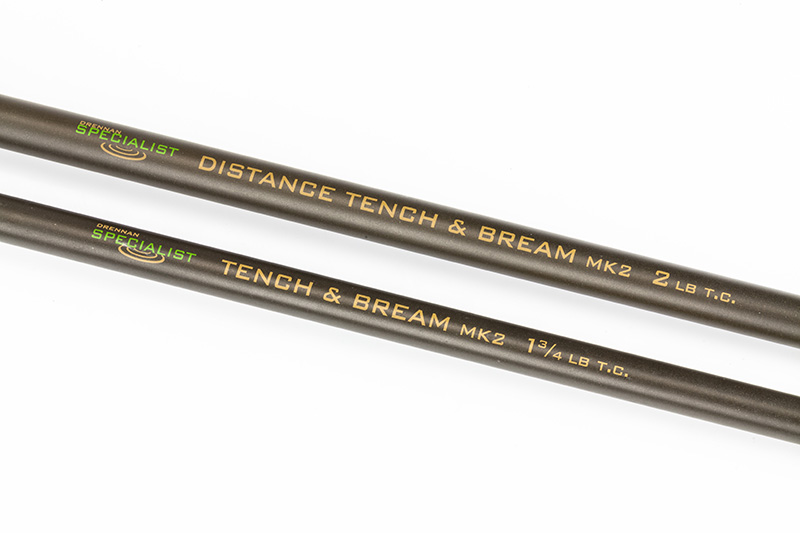



Korum 13ft carp float rod
Tech spec
- Weight: 325g
- Line Rating: 8lb - 15lb
- Eight ceramic line guides
- Full cork handles
- Heavy parabolic action
- Matt black finish
Now here’s something a little bit different from Korum, a new range of Carp Float rods in 12ft and 13ft lengths.
With 1.5lb and 1.75lb test curves, what’s so unusual about that, you may ask? Well, they are intended to put the fun and pleasure back into carp fishing, by enabling anglers to use stealthy float tactics rather than today’s more usual straight lead or Method feeder approaches.
The K-Flex carbon blanks have a powerful parabolic action that kicks in steadily as pressure is applied, and both rods will handle big carp with aplomb. Other key features include matt black livery, full cork handles, and rugged nylon reel seats with black metal hoods. You also get eight light, double-legged ceramic-lined guides.
The downside is that such a powerful progressive action reduces casting capabilities a tad, so if you’re harbouring notions of using one to plonk a 4AA waggler 30 yards out, forget it. They will indeed reach such distances, and more besides, but only when partnered with heavier floats from 20g upwards.
That’s not a negative in my book, as I reckon their longer lengths and superb action make these ideal stalking rods – the extra reach can be used to delicately present a baited hook close to marginal reeds or snags.
I can already hear mutterings that most stalking rods are short 7ft to 9ft affairs for dropping leads and PVA bags into holes in weed. But find a reed-fringed lake, get your chest waders on and put a few free offerings into likely looking spots. Chances are you’ll find a few fish feeding, and now you can silently drop a bait right on top of their noses, with instant and explosive results.
The reed-fringed waters of Willowbrook Lake in Northants play host to plenty of decent-sized fish that like to roam around the margins looking for spilled feed. So on a quiet Monday morning, armed with little more than a landing net and a boxful of corn, I wandered around the fishery with the 13ft Korum Carp Float rod.
Twitching lily stems revealed something moving down below, so I scattered a few grains of corn over the area and lowered in a small straight waggler shotted with three No8s spread down the line. Instantly my double corn hookbait was snaffled, and in a torrent of spray and boils the fish bolted off, leaving a wake worthy of any torpedo.
This is the moment when any carp rod worth its salt steps up to the mark. Tightening down on the reel’s clutch and holding the rod on the horizontal plane, I applied side strain that slowly but surely brought the fish to a halt.
The rod’s heavy parabolic action had more than done its job in tiring the carp, yet at the net it had enough flexibility in the tip to absorb my quarry’s last-minute lunges without risk of a hook-pull or a parting of the line.
Price | 13ft £44.99 | 12ft £42.99 |
Angling Times verdict
What a great rod from Korum this is! It’s loads of fun to use, with exactly the right blend of fish-playing power and finesse, and perfect for margin fishing when really big fish are on the cards. Its two-piece build means it can be easily carried to the bank ready made up, and is therefore ideal for a short evening stalking session with a float in the margins.
Mark Sawyer
Greys Toreon Tactical Float and Feeder rods
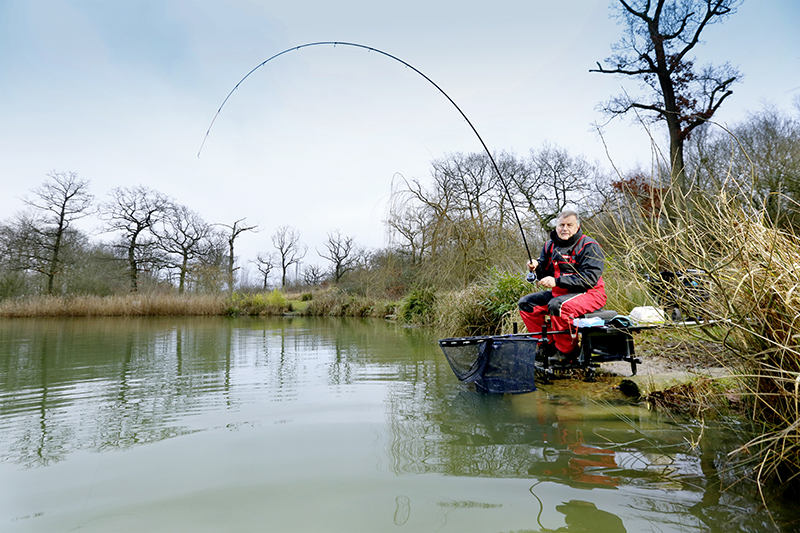
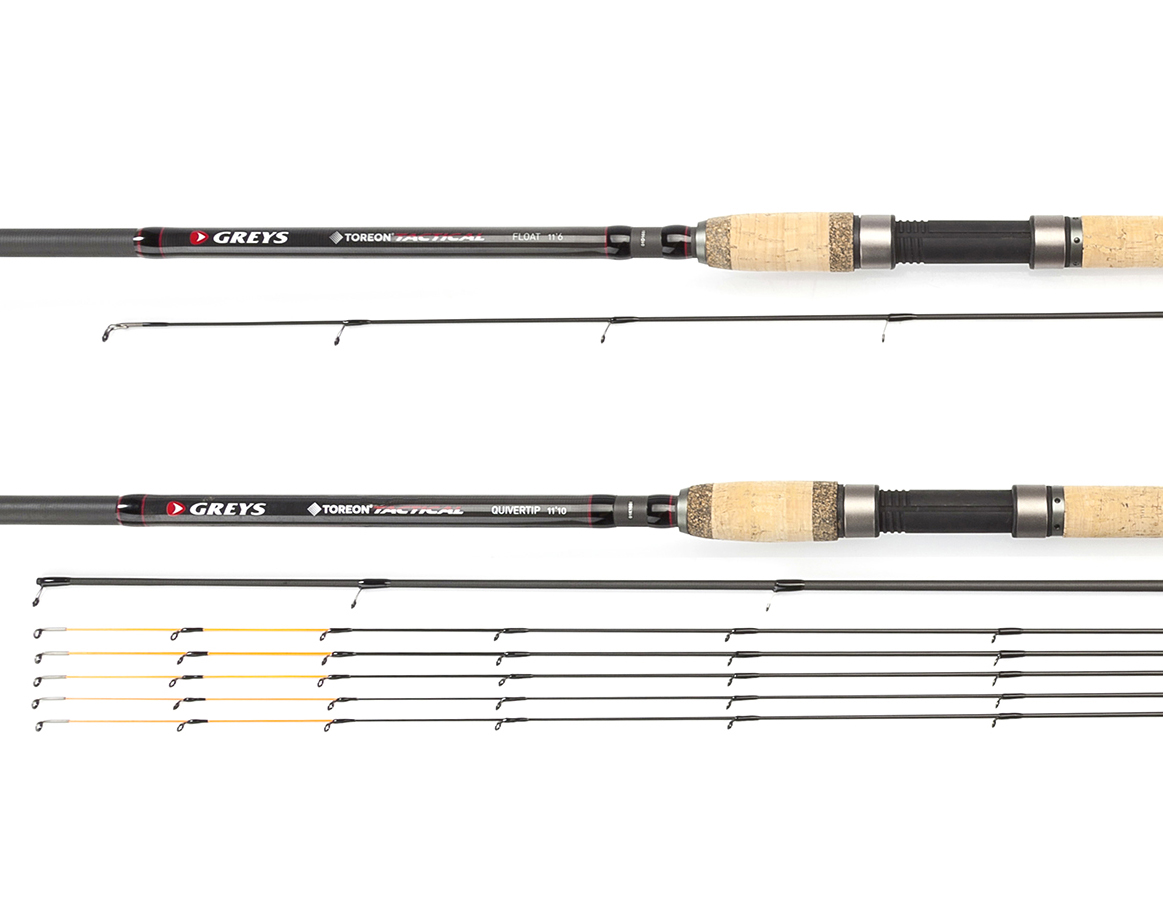

Greys has an impressive track record for iconic fishing rods – names such as Prodigy, Platinum and Air Curve are all instantly recognisable to big-fish anglers who demand the best.
So when news broke of a new rod range aimed at the serious coarse angler I just had to get my hands on a couple. The full Toreon Tactical family features four quivertip rods at 10ft 6ins, 11ft 10ins, 12ft 6ins and 13ft.All come with five graded carbon push-in quivertips. There are also five float rods in lengths of 10ft 6ins, 11ft 6ins, 12ft 8ins, 13ft and 15ft. Combine these with the quivertip rods and you have a rod arsenal able to tackle every imaginable venue, from tiny ponds to raging rivers.
Built from high modulus, lightweight Toreon nano-carbon, all rods are amazingly strong and responsive, and furnished throughout with quality lightweight gunsmoke SiC guides. Detachable cork butt grips allow for compact storage and variable handle lengths. These will be a blessing on the longer rods, giving more casting clout to those who like to whack it out a bit. The two rods on test, an 11ft 10ins quiver and an 11ft 6ins float model, should between them cover most ‘middle of the road’ situations and deal with everything from big commercial carp to shy-biting silvers. This in itself is quite unusual in an era when most modern coarse rods are built to do a specific job.
I would suggest, though, that if (after reading this review) you are interested in owning a Greys Toreon Tactical rod, you take a closer look at the full range before making your choice with so many rod lengths and recommended line strengths there will be something perfect for every fishery you may visit during the course of a season. Bearing that in mind, I took the test rods to a mixed fishery, the superbly well attended and blissfully peaceful day-ticket Wold Farm in Northamptonshire (www.woldfarmfisheries.co.uk). When the float dips or the tip goes round on Wood Lake you can never be too sure what’s having a nibble on the other end – it’s a kind of aquatic Bingo.
Starting on a 3AAA insert peacock waggler with a lightish 0.11mm hooklength and size 18 hook baited with double maggot, the 11ft 6ins two-sectioned rod soon put a few roach and half-decent skimmers into the netThe blank is crisp and responsive, with the backbone to cast big floats (including pellet wagglers up to 15g) without a hitch. Unfortunately, I didn’t catch anything hefty enough to test its anti-locking action, but for silvers alone it’s just about light enough to put a bend in the tip. The 11ft 10ins Toreon Tactical quiver rod was tested rather better as a run of pastie-sized carp took a liking to my bread disc hookbaits. The feisty little fellows showed plenty of spirit, but the blank’s flat spot-free action shrugged off their struggles and they were soon peering through the mesh of my keepnet.
It’s more than capable of handling medium-sized Method feeders, but although Greys rates its maximum casting weight at 185g (6oz-plus) that’s a tad optimistic in my opinion. I particularly liked the five blaze-coloured carbon quivertips which add to the rod’s versatility and help prove its worth as an all-rounder.
THE VERDICT
If you’re a journeyman coarse angler looking for a ‘one rod does it all’ bank side companion, then one – or perhaps two – from the new Toreon Tactical range are more than likely to be sliding into your rod holdall soon. Quality and performance are virtually guaranteed from Greys, one of the UK’s longest-surviving tackle companies with a fine history of producing hard-wearing, long-lasting and thoroughly satisfying fishing rods.
Mark Sawyer
PAY AROUND
£99.99 - £129.99
Browning Commercial King Tickler fishing rods
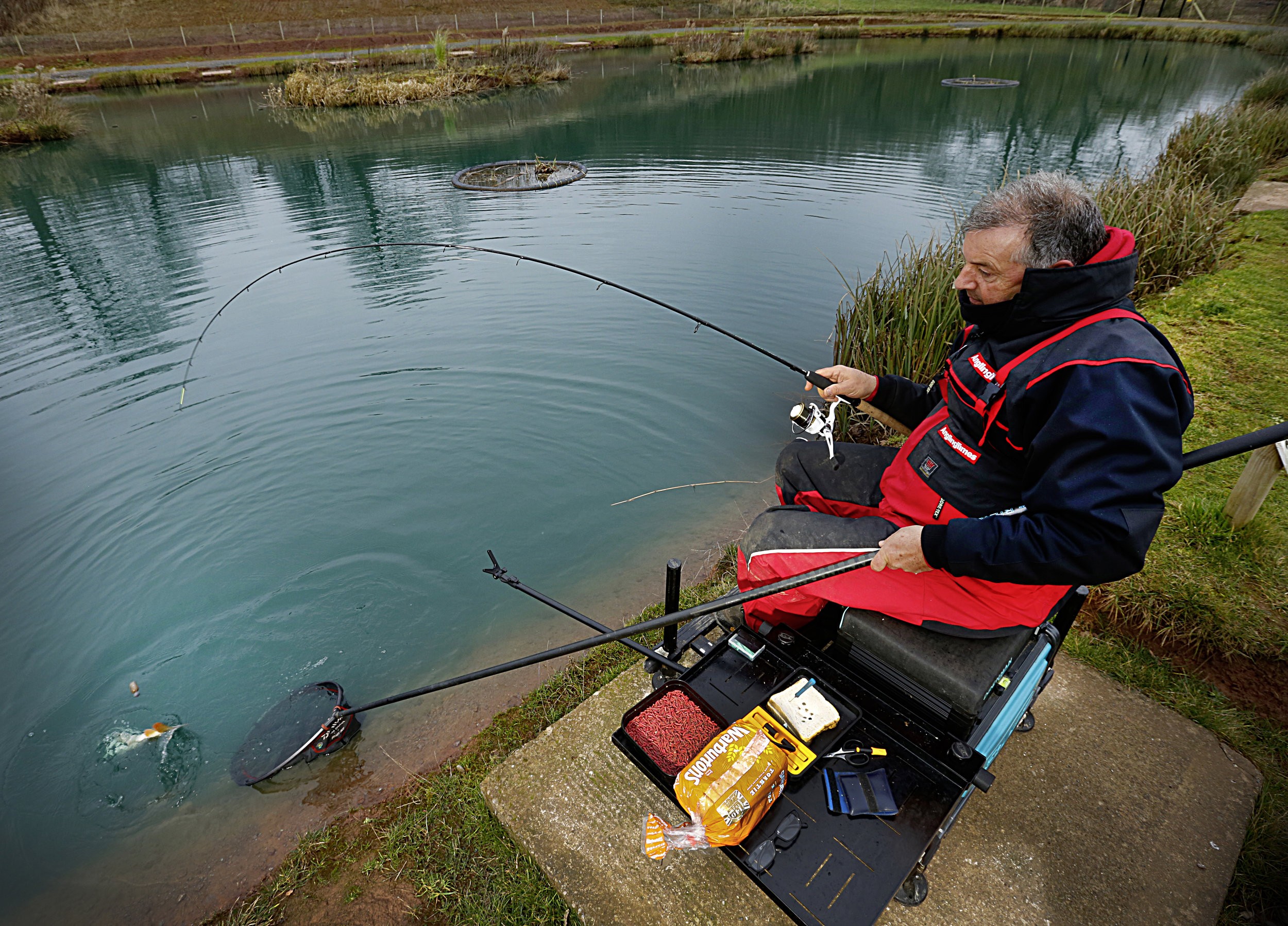
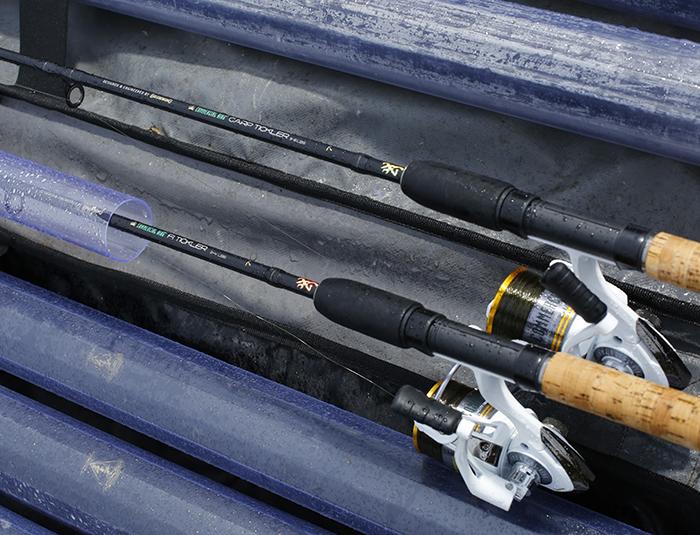
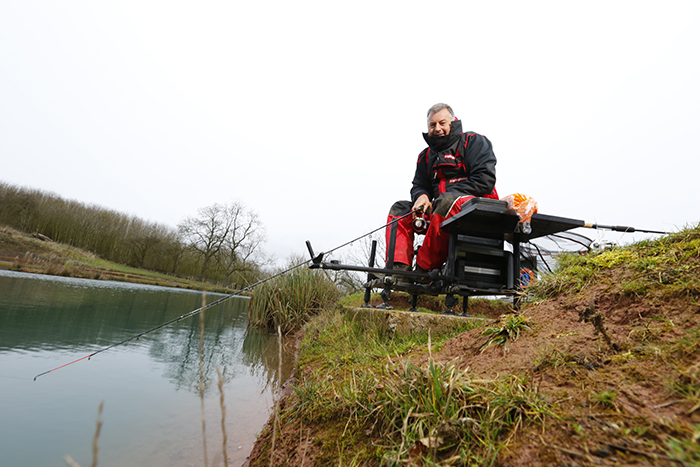
These tiny wands are called Ticklers – did Ken Dodd invent them so his Diddy Men could go fishing?
Well, oddly enough, no. These pint-sized single-sectioned Carp and F1 models are the latest additions to Browning’s popular Commercial King range. There’s nothing new about short or indeed single-sectioned rods, and few would argue against their having a place in the modern commercial match angler’s rod holdall. That is just where you can tuck your Tickler after a match, and very easily at that.
Simply remove the quivertip, place the hook into its retainer and reel up any slack line. Then it’s just a matter of folding the reel handle flat before sliding the rod into its slim, protective tube. There are no bands, sleeves or broken tips to worry about – the rod can be taken down and put up again quite literally in seconds.
For live test purposes I carried both versions to my peg at Monkhall Fisheries in Shropshire, ready made-up inside a standard rod bag containing five tubes plus a few mini pole extensions (and if you’re wondering about the blue colour of the water, it’s from a fish-safe dye used to keep weed growth to a minimum). Just to have them so close to hand and ready to use without the need to transport yet another rod holdall to the peg further endeared these rods of restricted growth to me. Yes, obviously they have their limitations, but for ease of transportation and convenience they tick my box.
The pair consists of a surprisingly substantial Carp Tickler model with a 50g (1.7oz) maximum casting weight, suitable for reel lines up to 8lb, and the lighter F1 rod with a casting weight of 35g (1.5oz) for reel lines up to 6lb breaking strain. The Carp Tickler has enough clout in its progressive fish-playing action to cope with specimens of 10lb-plus, while its lighter F1 counterpart shares the action while remaining just about light enough to handle small hooks and fragile hooklengths without risking hook-pulls or breakages.
During the live test, I fished for carp in deep water with the Carp Tickler set up with a 0.75oz straight lead and hair-rigged bread discs. I rigged the F1 rod with a 20g Drennan Carp feeder, size 18 hook and double maggot for fishing in shallower water up against an island.
During the session the wind got up from nowhere and, within seconds, wickedly cold snow flurries were driving across the lake. It really was ‘batten down the hatches’ stuff, but my fishing didn’t suffer at all, as the shortness of the rods had allowed me to tuck the rod-tips right into the bank. I hit every bite, and even when I had the brolly up I could still see the quivertips. As a bonus, I found I could net fish without having to negotiate the canopy of my brolly.
THE VERDICT
Well, I must admit to being completely sold on these new Browning Ticklers. I really liked the concept – packing away and setting up rods has never been easier or more lacking in fuss and drama. Being able to stick them inside my pole holdall was another big plus point. I found the Carp Tickler a little on the heavy side, and although I wouldn’t hesitate to use it for summer Method feeder margin work I would probably furnish myself with a pair of the F1 Ticklers for winter commercial fishing, preferring their softer cushioning action.
PAY AROUND
£79.95
Avid Curvex range
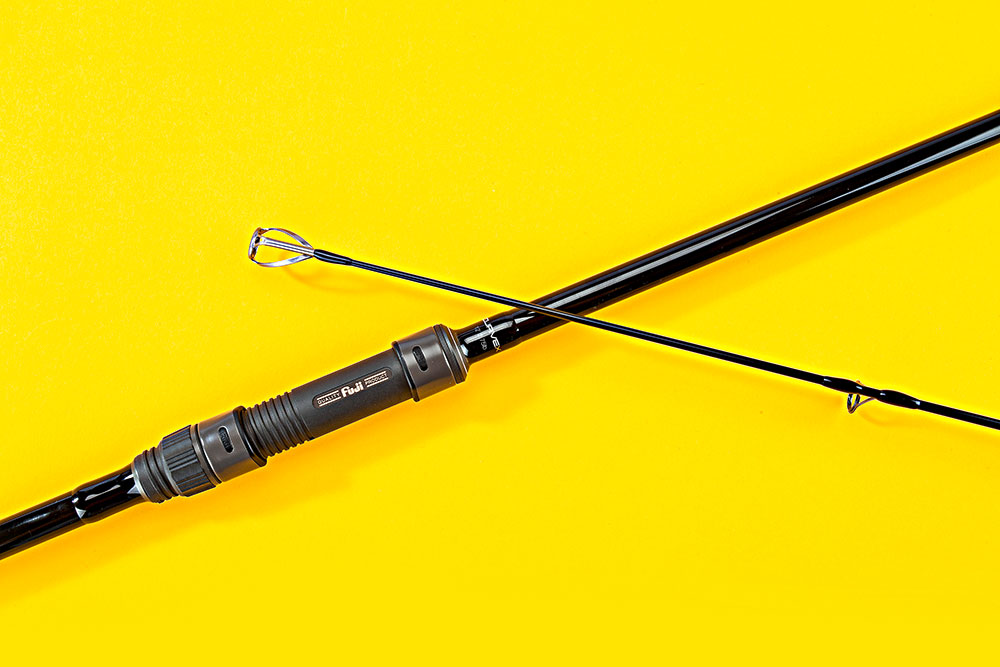
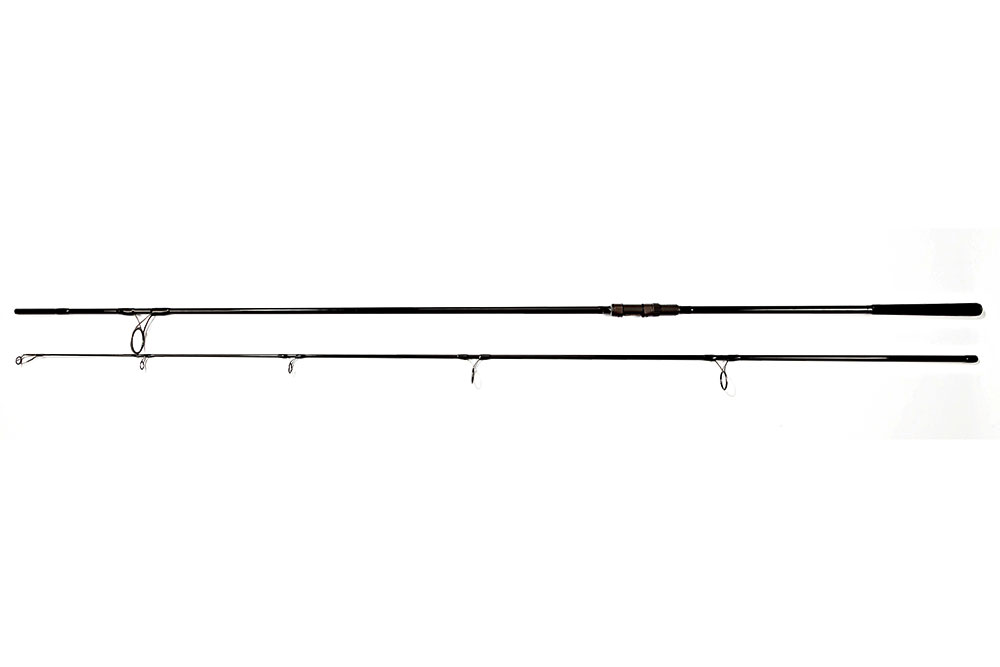
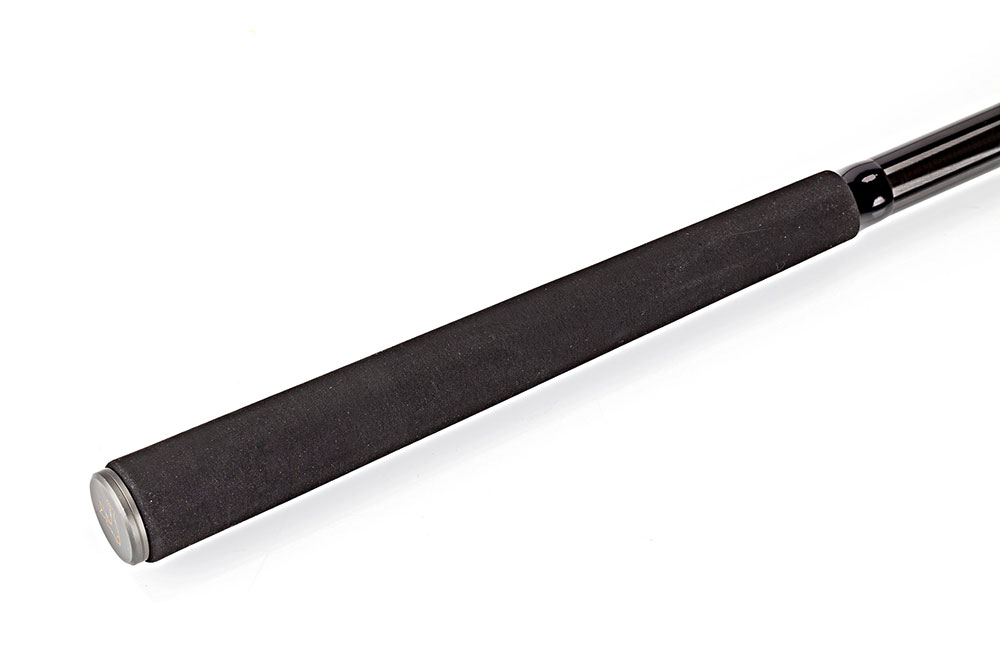
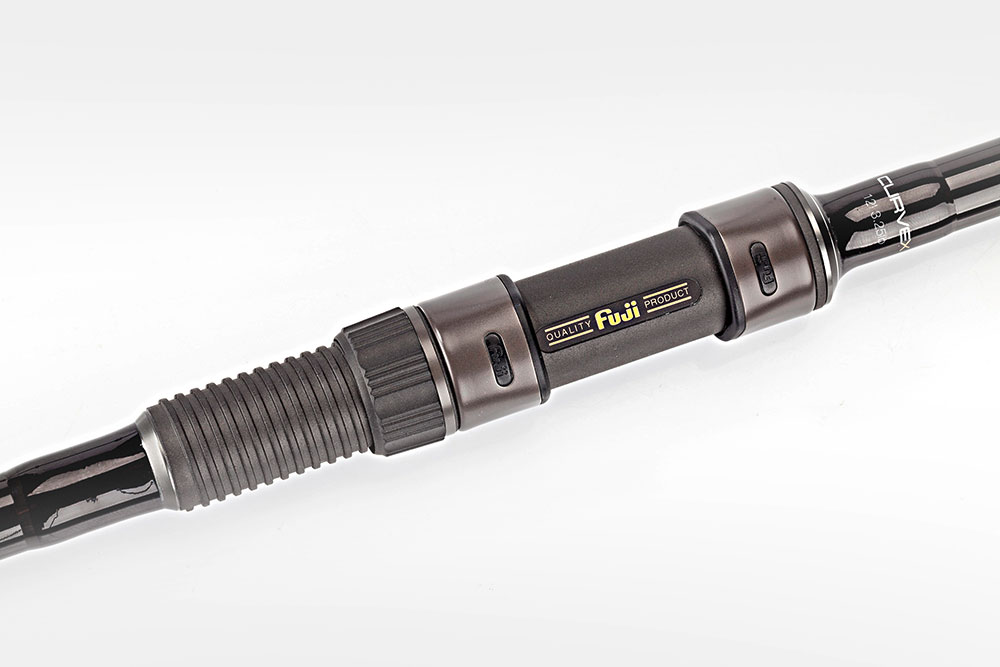
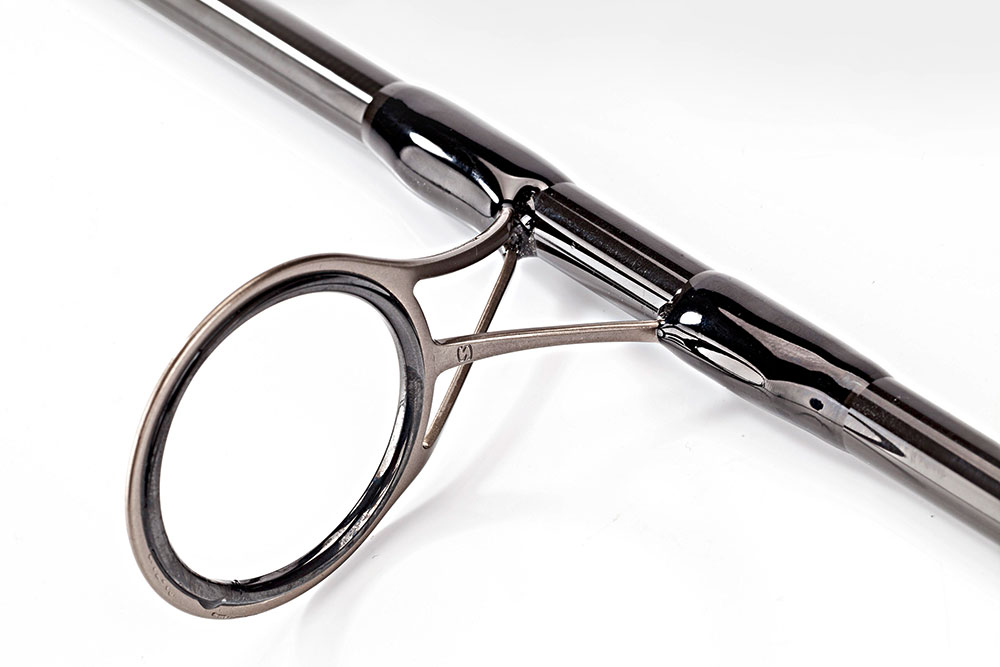
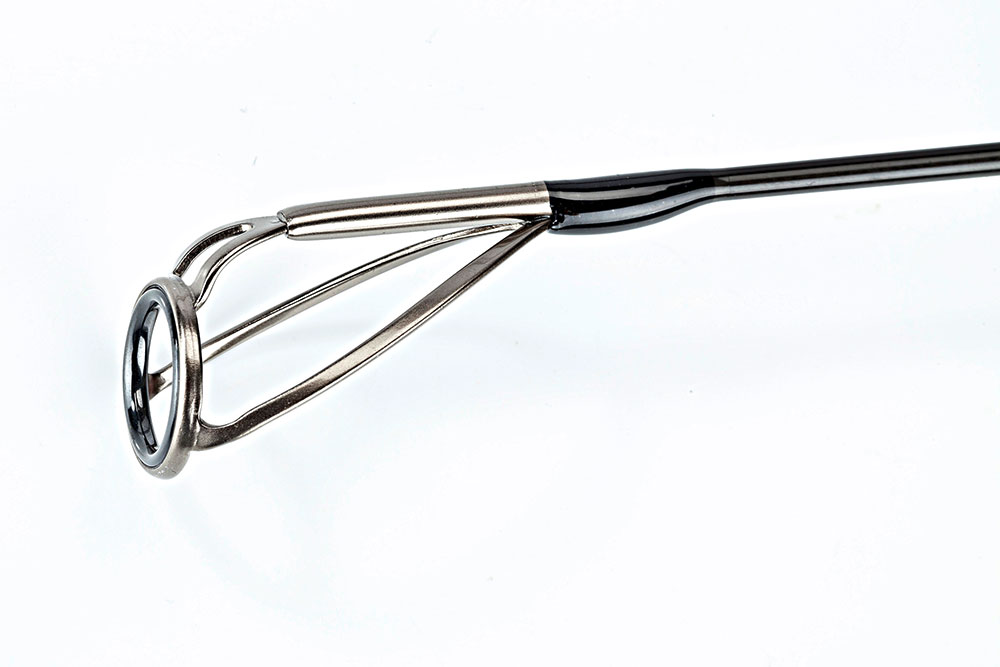
PAY AROUND
10ft, 3lb test curve £139.99
All others in the range £149.99
Big-carp brand Avid continues to come up with very innovative products, and these four new Curvex rods are bang on the mark, offering the modern carp angler something completely different from the norm.
Teaming an almost ‘old school’ through action with modern materials, these rods – coming in three lengths and four test curves – offer an intense fish-playing experience that allows the angler to feel every shake of the head.
The non-locking action doesn’t sit that well with casting to the horizon – but when you hook a big fish you can battle it with total confidence.
Even so, these two-piece rods have more than enough grunt for all but the largest of open waters.
It’s simply a matter of matching their 10ft, 12ft and 13ft lengths and 2.75lb, 3lb 3.25lb and 3.5lb test curves to your needs.
You can use them with smaller hooks, lighter hooklengths and thinner diameter reel lines without having to worry about hook pulls or painful partings of the way when your quarry makes a last-minute bolt for freedom.
There’s no doubt that finesse pays when the water cools and clears, and for that reason alone the Avid Curvex will appeal to anyone waking up to frost on their bivvy and grass crunching underfoot.
The ‘bend, and then bend some more’ action will also prove useful when big fish need to be played through weedbeds, or reeled in with washing lines of loose weed in tow.
Despite its best efforts you’ll be able to keep a big fish moving in the right direction without fear of breakage.
Other key features include original Fuji reel seats with Japanese shrink-wrapped handles, lightweight SiC guides throughout, anti-frap tip guides to prevent crack-offs, and 50mm enlarged butt guides on the 12ft and 13ft models.
All in all, these rods have the X Factor! It’s ‘four yesses’ from us!
Preston Competition Pro Super Light 9ft Feeder rod
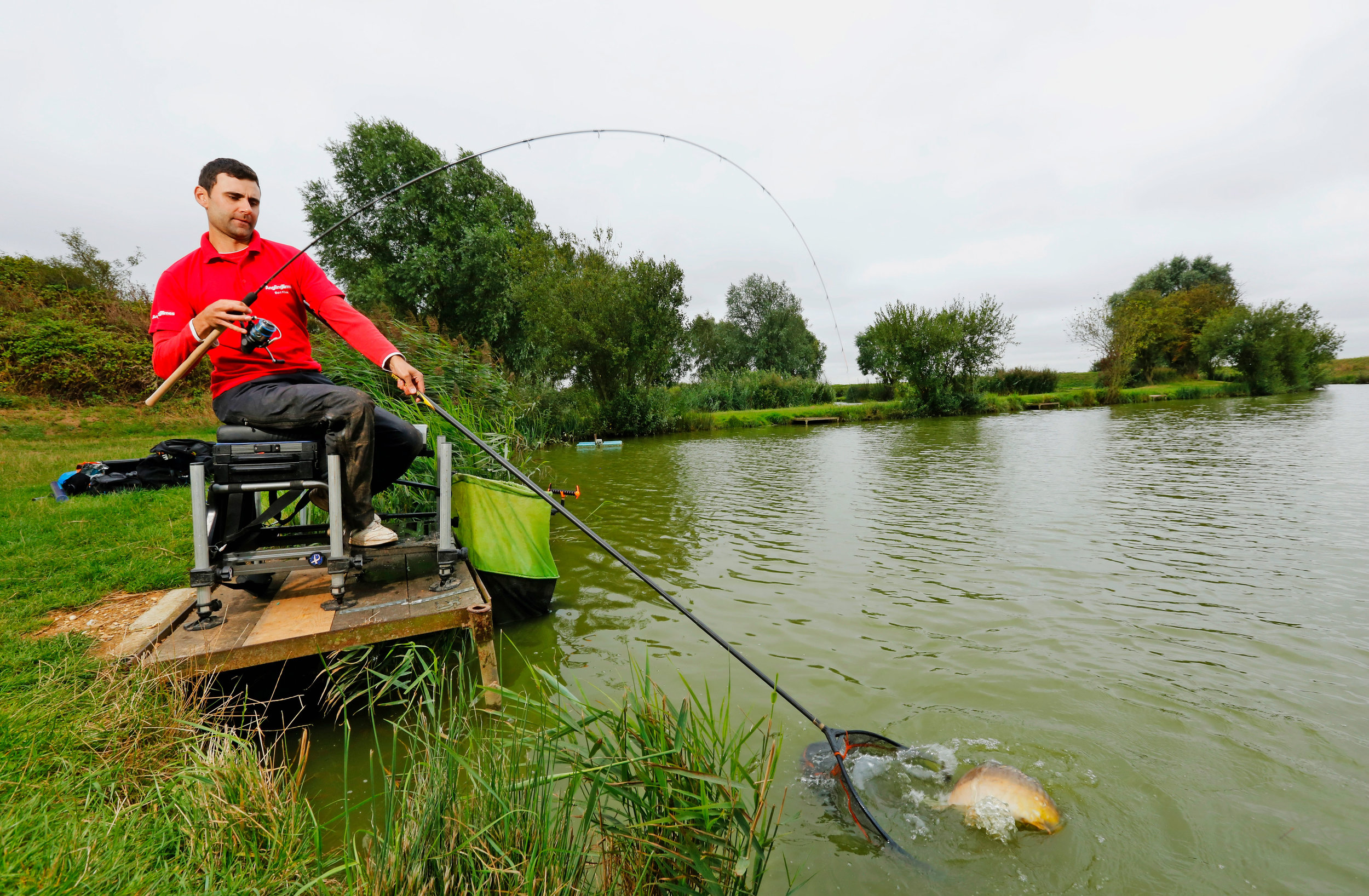
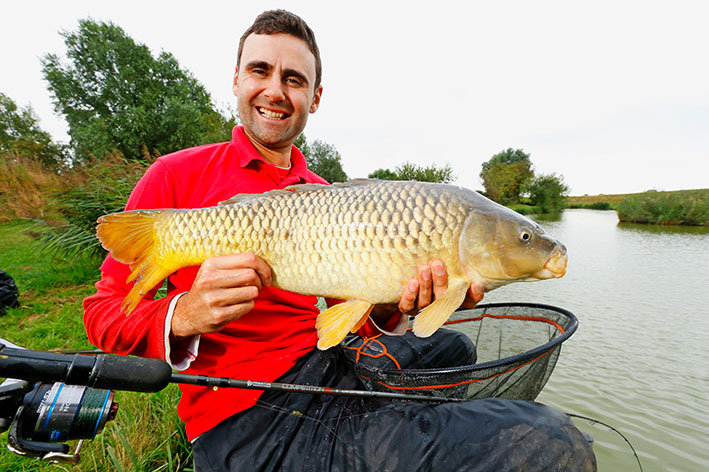
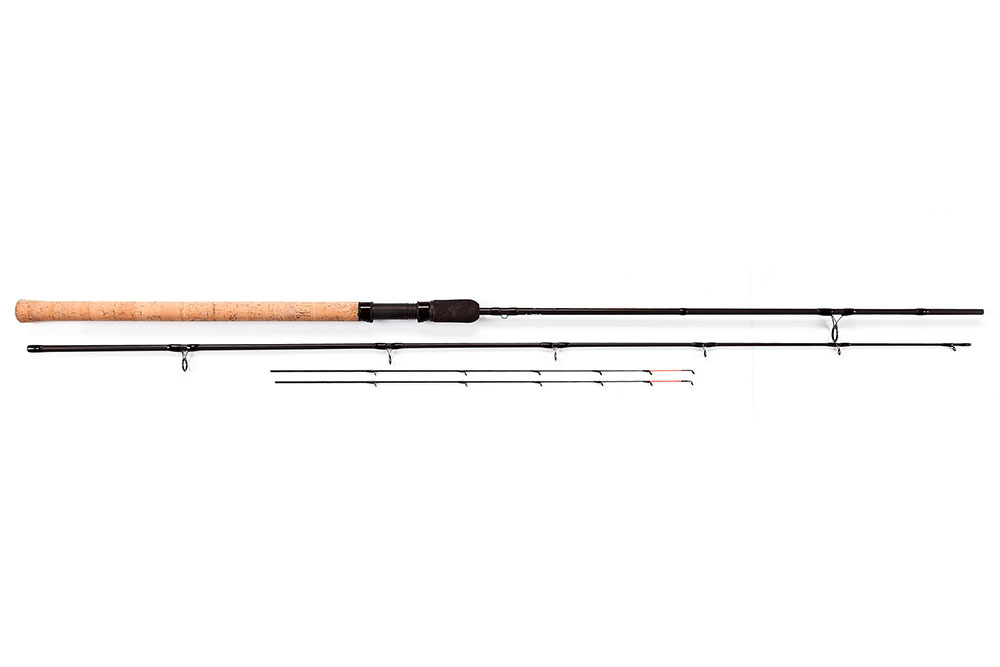
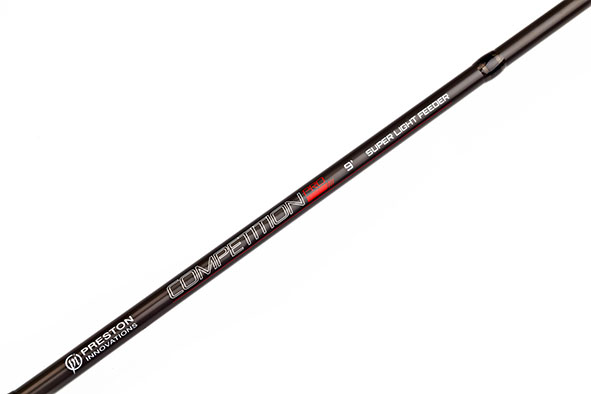
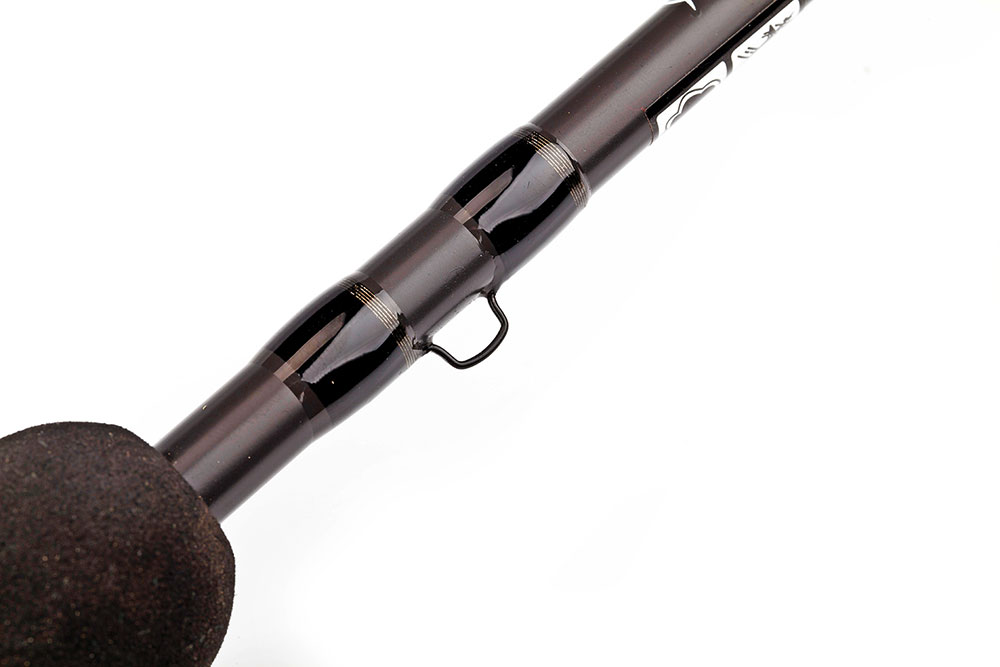
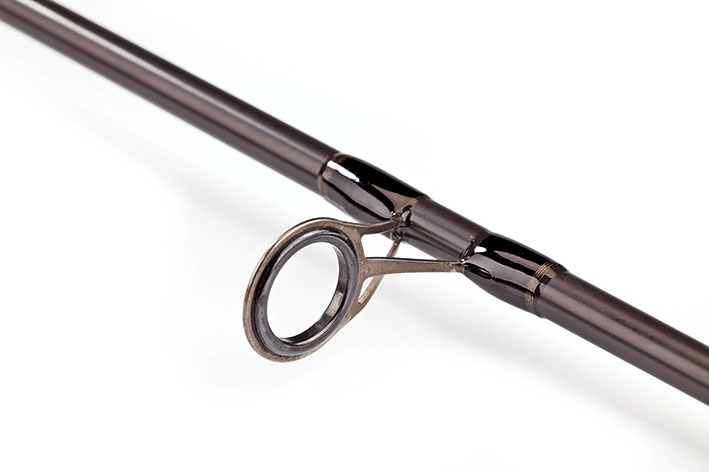
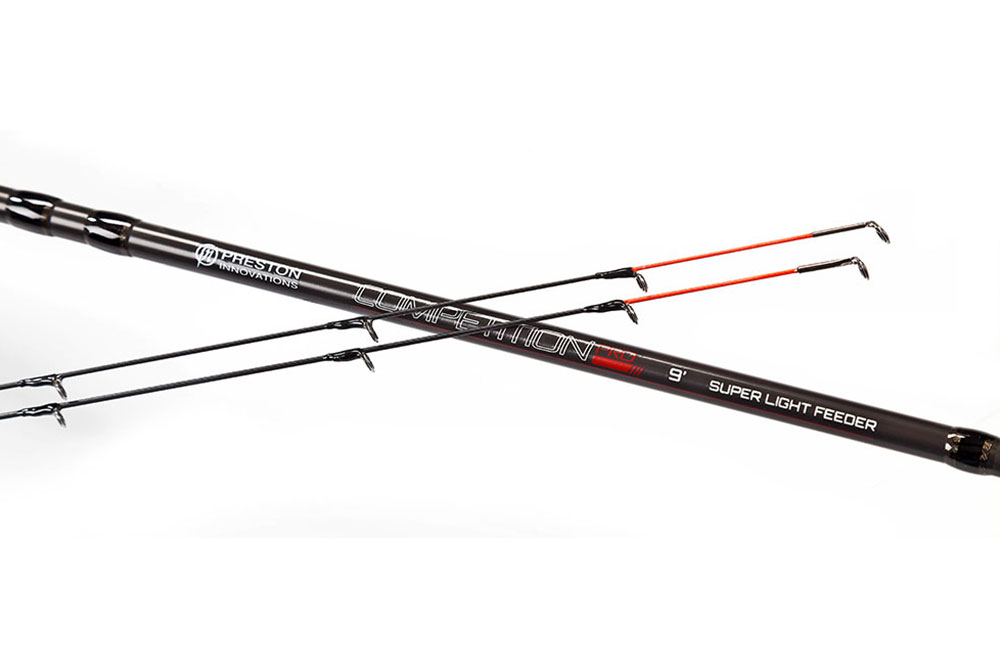
PAY AROUND
£89.99
There was a time when a ‘short’ rod was classed as 11ft maximum.
Nowadays a host of models in the 8ft, 9ft and 10ft class are available, including the Super Light 9ft Feeder from Preston Innovations. This is billed as a close-range tool for small feeders and bombs, and casts up to 30m.
It’s the baby of the Competition Pro range of feeder rods, which stretches right up to a heavy 13ft version. The Competition Pro is a definitely a series of all-round rods rather than out-and-out commercial tools, and although I could have taken it to a reservoir or a big lake and targeted small fish, it wouldn’t have been too much of a test. Instead it was thrown in at the deep end at Decoy Lakes’ ever-reliable Six Islands pool, which holds lots of carp in the 4lb-10lb bracket.
First, a note on the length. I absolutely love using a 9ft rod. Don’t get me wrong, it’s limited in terms of casting distance but for anything up to 35m or so it makes feeder fishing so effortless, especially with the hookbait tucked inside the frame of a Method or pellet version. A traditional open-end feeder with a long tail isn’t as aerodynamic, so a longer rod is needed to cast it properly.
With a 9ft rod, fish pop up under your feet for netting, as they do on a short F1-type top kit on a pole.
I clipped my line up for a short 16m chuck to the middle of the bowl at the car park end of the lake, where there is a sunken island. Believe it or not it’s quite difficult to discipline yourself to apply such a short cast – or it would be with a longer rod.
My 30g inline Preston Method couldn’t have been in the water much longer than 30 seconds when the 1oz tip I’d fitted pulled firmly round. A 5lb mirror carp was the culprit, and it was beaten in double-quick time. I quickly realised how much backbone and power this rod has, right through its faultless action. With several hooked carp I could feel the line grating through some submerged roots or vegetation on the bar, and I really had to give the fish some stick, standing up sometimes, to get them over it without breaking the hooklength.
Then I took the clip off and gave it a few good casts up the long sides of the lakes. This was surprisingly easy, helped by the large rod rings towards the base of the blank. I reckon you could punch a Method feeder 45m or 50m if you really went for it.
My final trick was at much, much closer range. I’d been throwing a few handfuls of pellets in the margins and a gentle underarm lob sent the feeder down there.
The rod was almost wrenched from my hands as I caught barbel and several more carp, including a double-figure common, which all made off towards a snaggy corner with an aerator. Despite a few hairy moments the Super Light Feeder took everything thrown at it, and smaller, softer rods like this mean fewer hook pulls too.
Nash KNX Carp Rod 3.5lb Test Curve
TECH SPEC
Test curves: Available in 2.75lb, 3lb and 3.5lb test curves. A 4.5lb Spod/Marker dual concept rod is also available
Handles: Full EVA Duplon handles on KNX carp rods, abbreviated shrink grips on KNX Spod/Marker rod
Guides: Exclusive Flexor guides for reduced blank distortion and greater power transmission, 50mm butt rings on 3lb, 3.5lb and 4.5lb Spod/Marker models
PAY AROUND
12ft 2.75lb £76.99
12ft 3lb £87.99
12ft 3.5lb £98.99
Spod and Marker 12ft 4.5lb £87.99
When carp rods look this good you’d expect two things of them – great performance and a hefty price tag. In the case of the KNX models, Nash has well and truly delivered one of these.
First let’s deal with the all-important looks. The completely non-reflective matt black blanks with matching gloss black decals may at first glance seem a tad dull, but they certainly give the rod an expensive classy look, guaranteed to draw admiring glances wherever you set them up.
When it comes to tasteful fittings and fancy furnishings, these KNX’s are of designer boutique standard. Their modern EVA and Duplon handles offer an easy, comfortable grip for casting and playing fish, and are finished with a laser-etched butt cap, complete with isotope slot.
A sultry black soft-touch rubber reel seat raises comfort to a whole new level – thanks to its clever skeletal design your thumb and forefinger can come into contact with the blank, giving improved ‘feel’ transmission from fish on the end.
Moving up the blank, you’ll find a line clip, then a 50mm butt guide on the 3lb and 3.5lb rods, followed by five more ideally-placed Flexor guides that reduce stress distortion during casting and give a seamless performance when playing a fish. Spigot alignment markings ensure the rod is always set up with the guides lined up straight. So this rod really does seems to be a class act, but what about its performance and price?
Price-wise it’s got to be a steal at £98.99 for the 3.5lb version on live test duty, £87.99 for the 3lb rod, and just £76.99 for the 2.75lb baby of the bunch.
With limited time available, the live test was geared towards what the 12ft, 3.5lb test curve blank is capable of.
I can happily report that it was more than capable of casting 3oz leads teamed with solid PVA bags and mesh sticks. Admittedly it isn’t an out-and-out casting tool, so if you’re thinking ‘unbridled power’ you may be slightly disappointed. The carbon composite blank doesn’t generate uite enough energy from its butt section, and loads the casting weight a little bit further down the tip than a horizon-buster of a rod.
That said, and for the money, Nash KNX rods are perfect for small to medium-sized carp waters where casts of up to 75 yards using solid PVA bag and mesh sticks are needed.
The progressive action makes it far less prone to hook-pulls than the ‘broom handle’ 3.5lb rods of yesteryear, which had no fish-playing action and scant feel. The KNX will handle fish from low doubles upwards, and make it a joy to catch them.
Completing the KNX collection is a Spod/Marker rod with a powerful 4.5lb test curve – so you can have a matching set if you feel like pushing the boat out.
VERDICT
Nash KNX carp rods offer the highest spec available in their modest price bracket. With on-trend looks and custom-built qualities, these multi-talented tools are ideal for venues – and carp – of all sizes.
If you’re just getting serious about your carping, and are looking for a set of good rods that won’t break the bank, I would take a long serious look at these.
Shakespeare Superteam Match 13ft rod
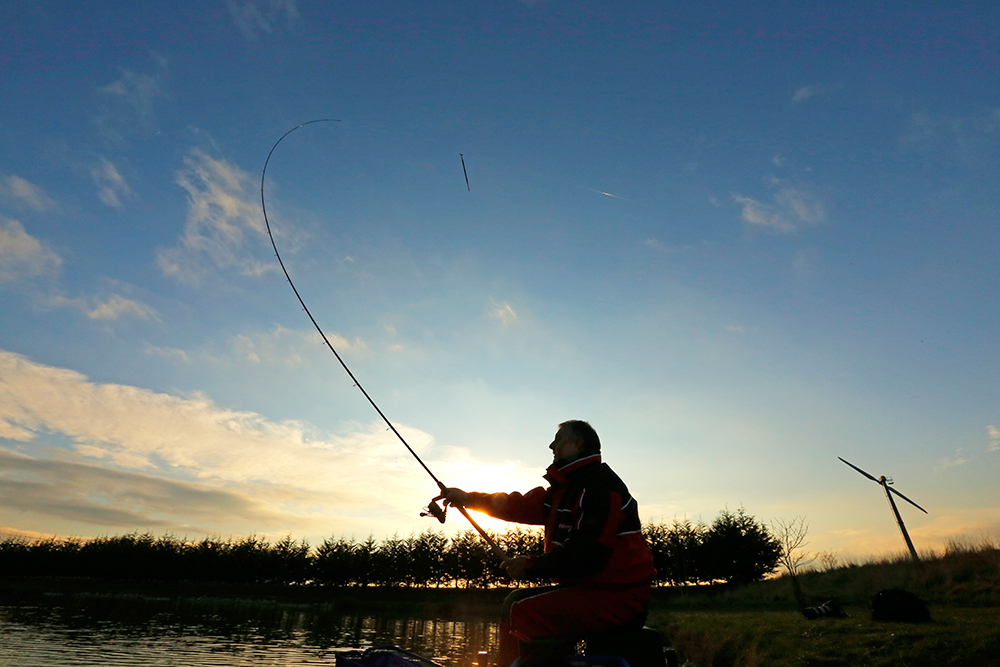
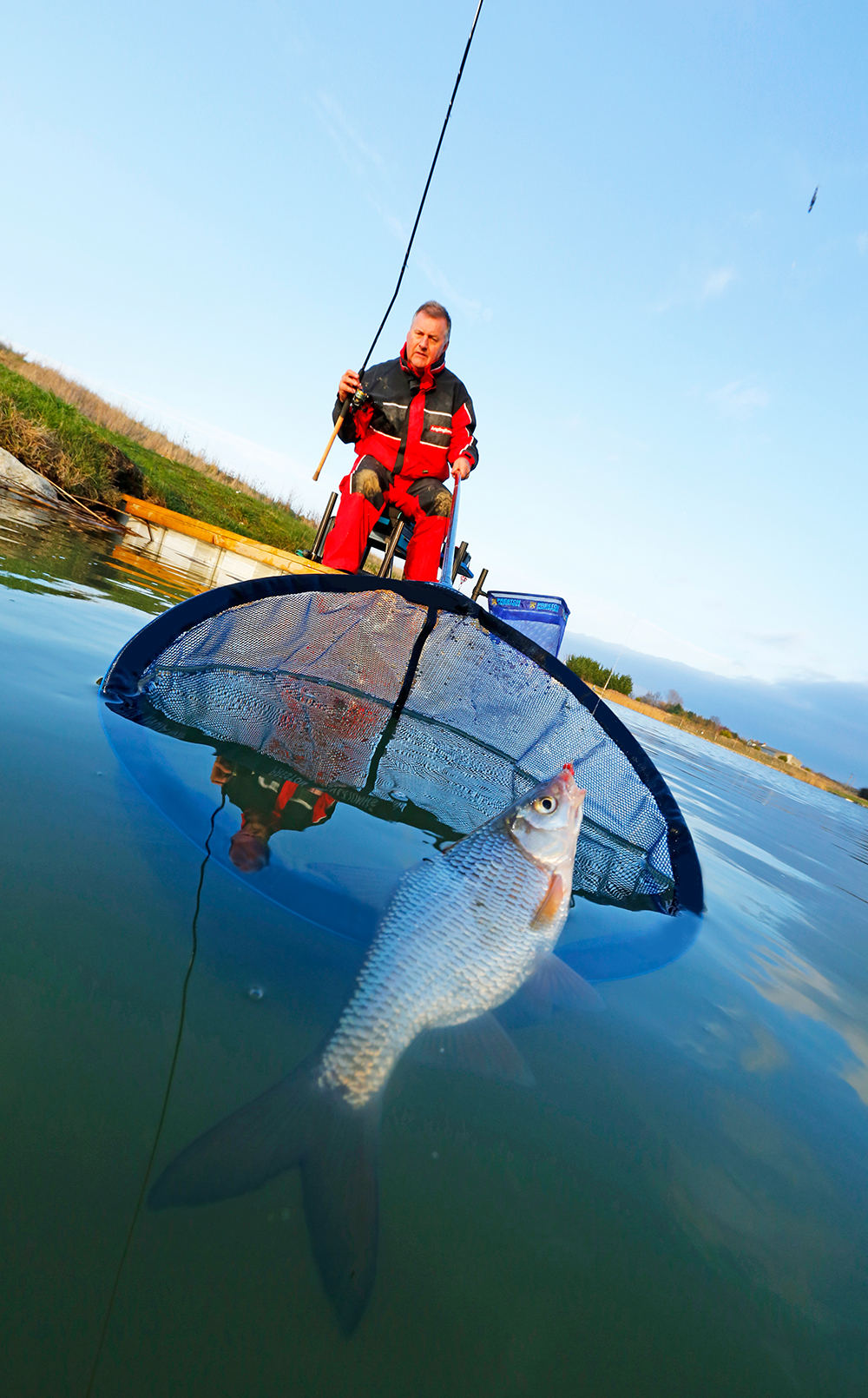
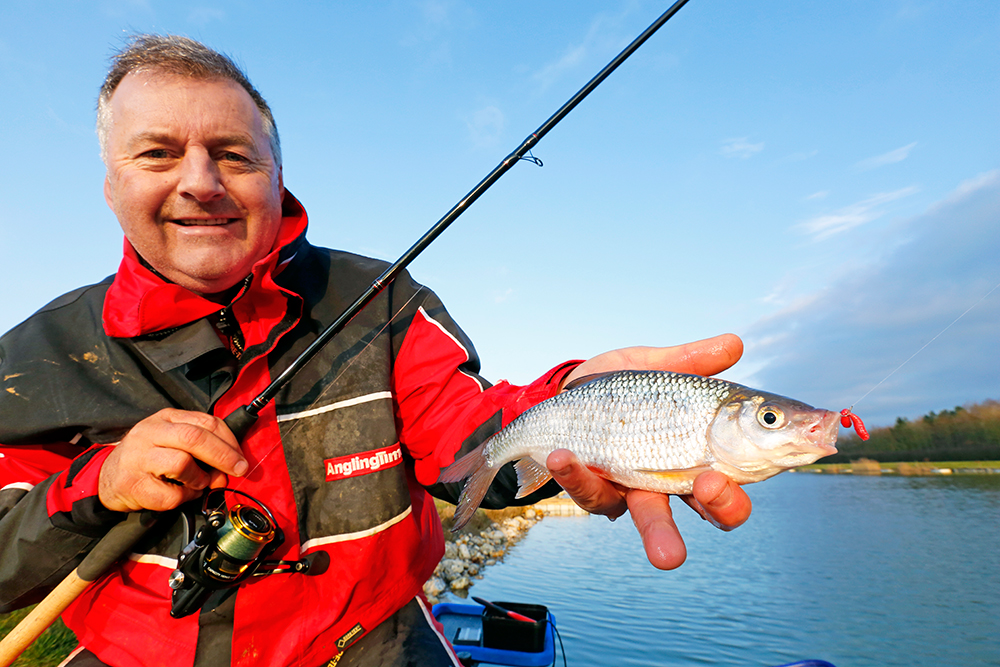
TECH SPEC
Length: 13ft
Power rating: 6lb
Pieces: 3
Handle: Cork/EVA
Rings: Zirconium
Extras: Side keeper ring
PAY AROUND
£89.99
You could do worse than use the Redditch tackle giant’s products down the years as a means of charting the development of the modern match fishing rod in terms of materials, furnishings and specifications.
A potted history of Shakespeare notables would show the fibreglass Match International as a rod ahead of its time. This was followed by the excellent, if rather expensive, President which I believe was the first carbon fibre rod to be built with a spliced-in tip.
Then we had the superb Mach 2 Boron which held centre stage with matchmen for many seasons, but was eventually superceded by the Mach 3 carbon. Since then we have been blessed with the firm’s high-modulus carbon Superteam model, launched in 2014.
Shakespeare did, of course, introduce many other match rods but those listed above were widely recognised as being as good as it got back in the day. Remember, it wasn’t all that long ago that match fishing was all about using a waggler or stick float to catch winning nets of roach, chub, dace, perch or bream, the tool of choice being a 13ft, three-piece.
The finesse to deftly flick a small waggler across a canal, cleanly pick up line from the surface when long trotting and cast bodied wagglers or sliders into deeper water on rivers and lakes, are qualities we expect of any good match rod.
That brings me nicely on to Shakespeare’s Superteam 13ft match rod which really is a jack of all trades and will take all these tasks in its stride. Yes, this rod was first introduced a few years back, but that doesn’t make it in the least bit tired or dated. It remains to this day one of the best all-round match-style float rods that few others can hold a candle to.
The three-piece pencil slim carbon blank is nice and light in the hand, making it easy to hold for long spells, and a requirement of any good river rod. Worthy of note are its zirconium oxide guides that enable almost friction-free line travel, very useful when trotting a river at the pace of its current.
Its fast, progressive action doesn’t lock up under stress, so when you hook into a really big fish the blank will absorb and keep absorbing its runs and lunges with no fear of the line snapping. At the same time it has the backbone to boss fish away from snags.
Live testing the rod was interesting, as I already had some idea about the Superteam’s performance from an earlier Angling Times review. This time, rather than take it to a carp puddle or river, I thought I would test the blank’s sharpness and line pick-up qualities on a deep venue I knew held some big roach and decent ide.
Waggler tackle with small hooks and maggots, coupled with a nagging easterly side wind, wasn’t perhaps the ideal mix for a decent day’s fishing. But I needn’t have worried – Shakespeare’s finest 13ft of carbon cast a hefty three-swan insert waggler with ease and unerring accuracy.
With the float set at 12ft deep, line pick-up speed was central to hitting bites and the rod didn’t disappoint, connecting time and time again with the most tentative of enquiries.
As the fish responded to the feed they started coming up in the water, and bites became lightning-fast.
Now the line needed to be whipped from the surface at a rate of knots, and yet again the rod performed impeccably. Not merely a jack of all trades but a master of them all.
VERDICT
Another pure class floatfishing rod from the Shakespeare stable and perfect for silverfish, the Superteam 13ft is tactically flexible and ultra-reliable. Use it with confidence, however light the terminal tackle. Its anti-locking nature and progressive action allows it to cope with sizeable fish, something that cannot be said of many old-school float rods.
Free Spirit CTX 10ft carp waggler rod
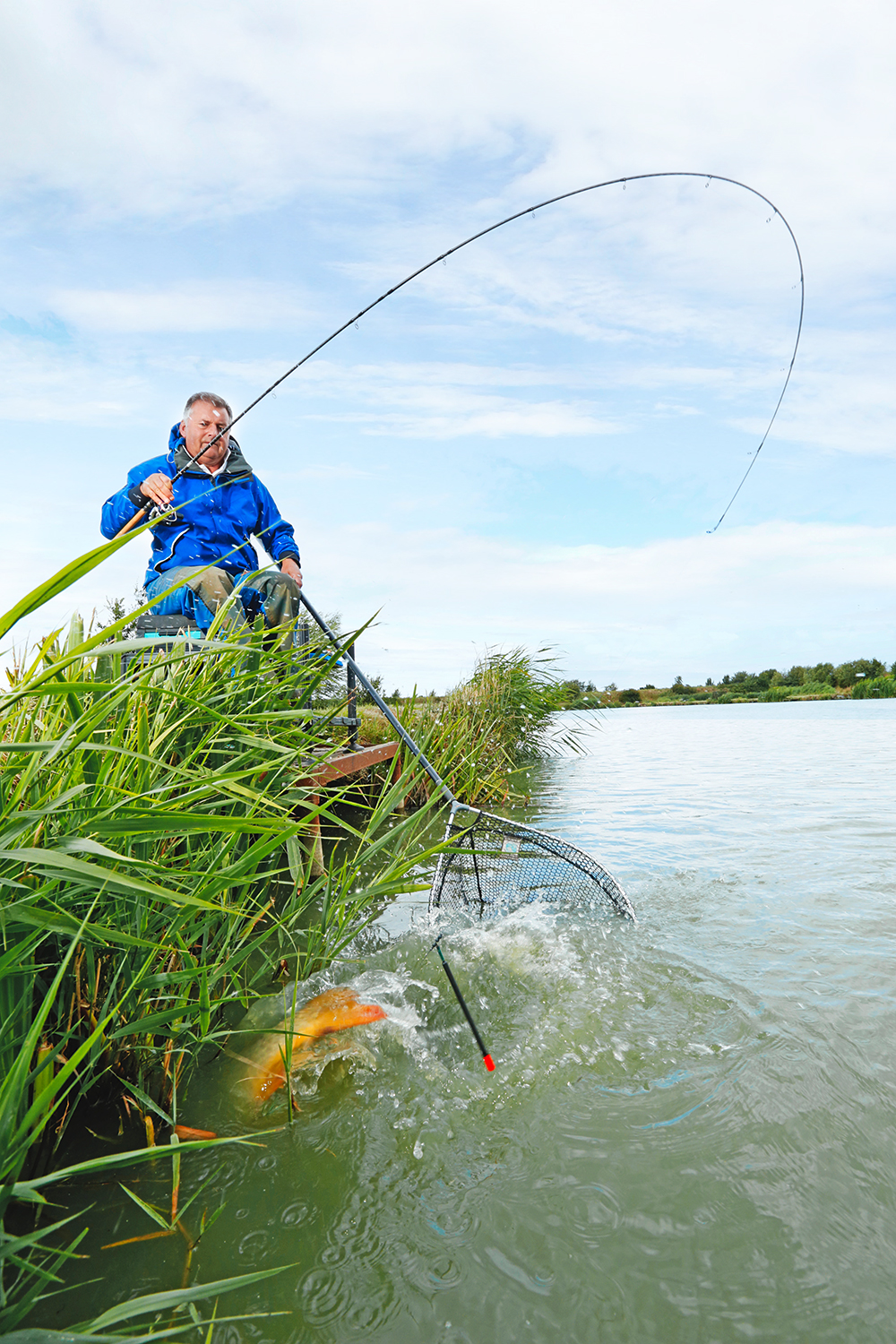
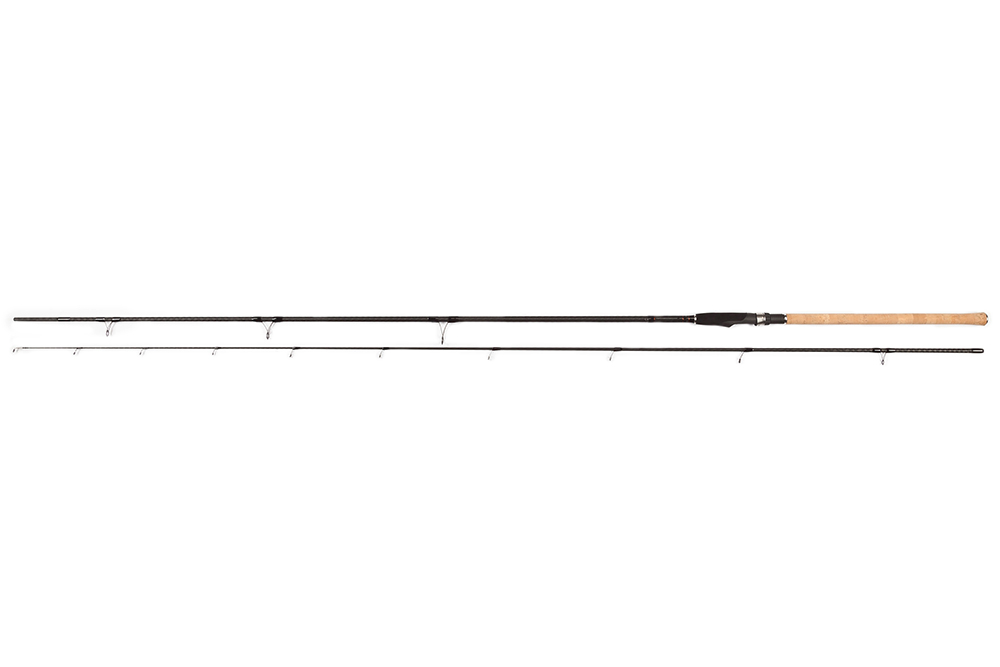
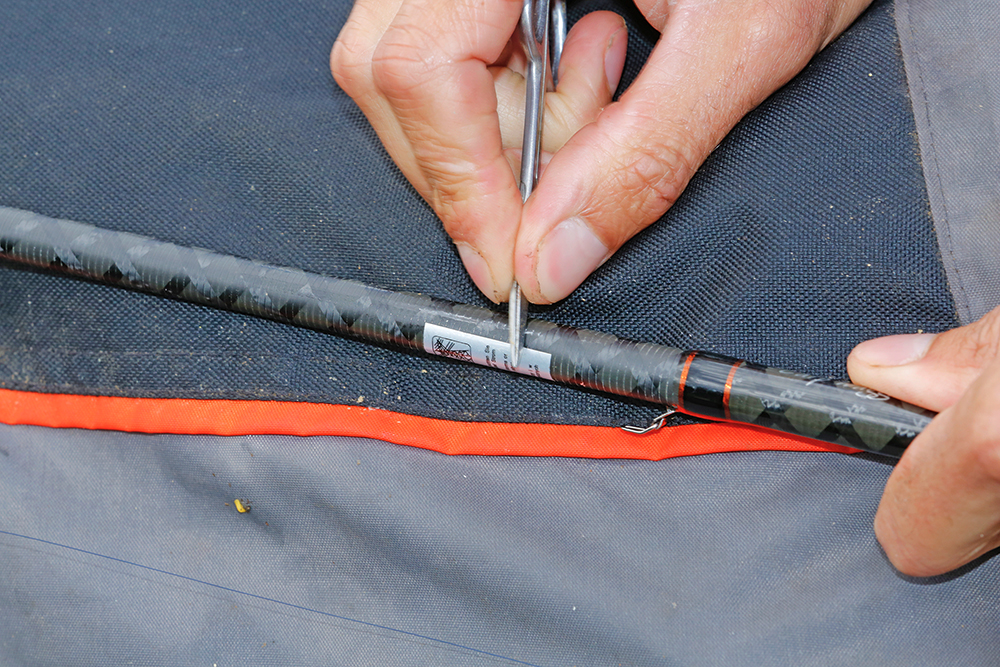
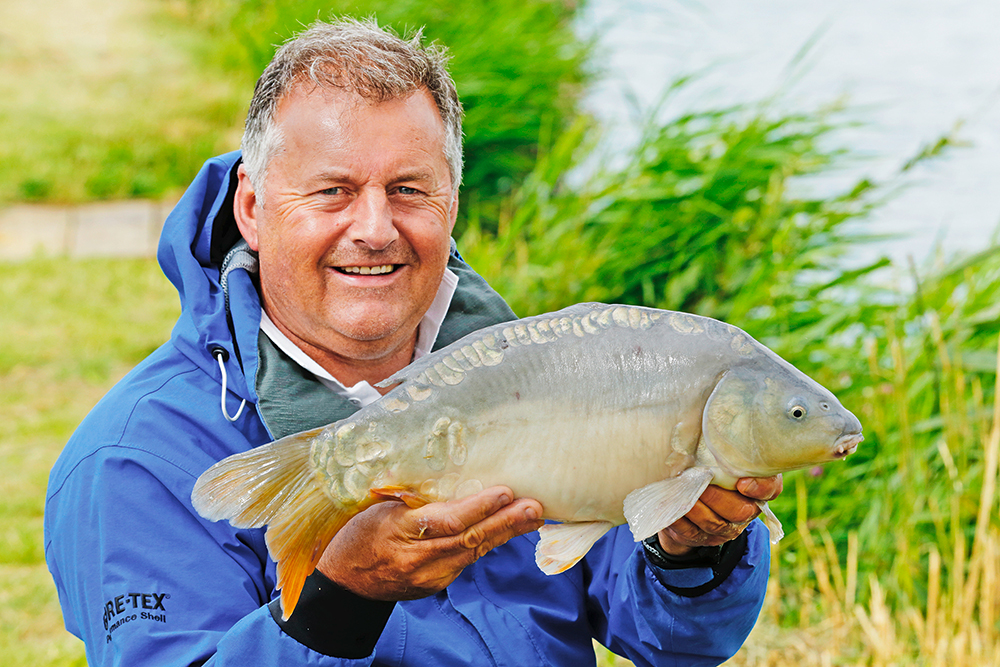
PAY AROUND
£94.99
On September 5, five Carp Waggler, five Carp Feeder and two Multi-Feeder rods from Free Spirit will hit the tackle shops.
All use the company’s tried and tested CTX specification, which has proved so successful in its carp and barbel rods.
The 40 tonne carbon blanks’ Bi-Axis weave makes them exceptionally light and immensely strong, and their brilliant paint and lacquer-free Perdurable finish is impossible to mark.
Other key features include reduced length handles (although the stepped-up SU Waggler and BW Feeder rods retain long handles for distance casting). The action of all the new rods gives an even build-up of power from tip down to butt, more than enough to stop powerful fish on light gear without the blank bottoming out.
Fast forward to the Oaks Strip at Decoy Lakes, near Peterborough. An early numbered peg at the top end of the Oaks, with the wind off my back, would in all likelihood prove to be a good testing ground for the CTX 10ft Carp Waggler rod.
Fitting the two sections of the rod together, it immediately struck me how slim and light it is. It doesn’t feel or look like an ordinary pellet wag chucker, either, being almost reminiscent of the featherweight old-school rods we used for squatt fishing on the Grand Union Canal.
There’s enough whip in it to be used with floats weighing as little as 3AAA. But the elfin 10ft blank still has more than enough poke to propel a waggler headlong into the strongest of winds.
This I discovered when, mesmerised by its all-round casting, fish playing and handling, I walked the rod round to the other side of the lake where my work colleague Ben Fisk was
live-testing a new margin pole.
Ben, one of the best young match anglers in the UK, is normally a man of very few words. But after just a few casts, and a couple of lucky early mug fish, he turned to me and asked whether he could ‘borrow’ the rod for his forthcoming weekend matches.
That alone should tell you how good the CTX 10ft Carp Waggler is.
VERDICT
Well, occasionally you just don’t see something coming. The comfort of its handling, the tip speed, faultless non-locking parabolic action, classy guides and woven carbon blank make this by far the best 10ft waggler rod we have seen, and at a price that won’t cause credit card meltdown. Go to your nearest tackle shop and have a look at one if you think I’m kidding.

